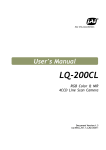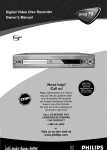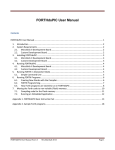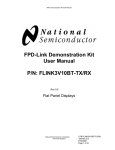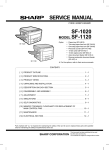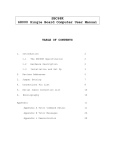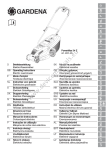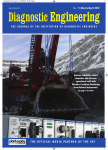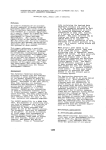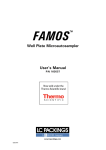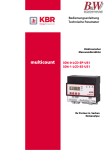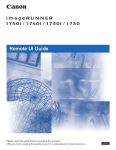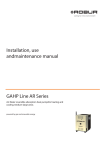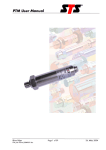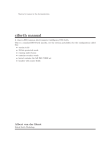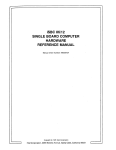Download FT-86C and FT-86C/FP USER`S MANUAL FORWARD
Transcript
FT-86C and FT-86C/FP
USER'S MANUAL
FORWARD TECHNOLOGY
INCORPORATED
document number 4301000, 9/81
This manual is intended to give the user of the FT -86C and FT -86C/FP a guide to
system functionality and also to enable the user to add peripheral, memory and other
devices to satisfy specific requirements.
The FT -86C and FT -86C/FP give users the
capability to quickly add components without needing a detailed understanding of the
8086 or its support chips.
For specific device timings we recommend that you refer
to the manufacturer's literature listed in Appendix B.
© 1981 FORWARD TECHNOLOGY INC.
FORWARD TECHNOLOGY INC., 2595 Martin Avenue, Santa Clara 95050
PHONE:
TWX:
(408) 988-2378
910-338-2186
TABLE OF CONTENTS
SECTION
TITLE
PAGE
SPECIFICATIONS •
v
1.0
INTRODUCTION
1-1
2.0
INST ALL ATION PROCEDURE AND OPTIONS
2-1
2.1
2-1
MUL TIBUS CONTROL
MUL TIBUS OPTIONS
•
2-2
COMMUNICA TIONS OPTIONS
•
2-2
2.1.1
2.2
2.2.1
3.0
.
COMMUNICA TIONS CLOCK STRAPPING •
2-2
2.3
EPROM TYPE •
2-9
2.4
WAIT STATE TIMING.
2-10
205
INTERRUPT STRAPPING.
2-11
THEOR Y OF OPERATION FT -86C •
3-1
3.1
BUS ELEMENTS
3-1
3.1.1
BUS CONTROL .
3-2
3.1.2
LOCAL BUS.
3-2
3.1.3
I/O BUS •
3-2
3.2
3.3
3.4
3.5
MEMORY
3-2
3.2.1
RANDOM ACCESS MEMORY.
3-2
3.2.2
PROGRAMMABLE READ ONLY MEMORY.
3-2
TIMING.
3-5
3.3.1
CLOCK GENERA TOR •
3-5
3.3.2
PROCESSOR TIMING
3-5
3.3.3
BUS CONTROL TIMING
3.3.4
BUS TIMING.
COMMUNICA TIONS
•
•
3-5
3-6
•
3-7
3.4.1
READ REGISTER FUNCTIONS
•
3-9
3.4.2
WRITE REGISTER FUNCTIONS •
3-9
3.4.3
PROGRAMMING THE WRITE REGISTERS •
3-9
3.4.4
PROGRAMMING THE READ REGISTERS •
3-10
INTERRUPT CONTROL •
3-12
TABLE OF CONTENTS (Cont.)
SECTION
4.0
TITLE
BREADBOARD INTERFACE.
4.1
4.2
4.3
MEMORY ADDRESS BUS
I/O ADDRESS BUS
DATA LINES
4.3.1
4.3.2
4.4
4.5
MEMOR Y DATA BUS •
I/O DATA BUS •
CHIP SELECT DECODING
•
EPROM CHIP SELECTS
RAM SELECT LINES
•
CONTROLFOR TH •
MONITOR COMMANDS
5.2.1
5.2.2
5.2.3
5.2.4
5.3
.
.
SUBSTITUTE.
MOVE.
MATCH
.
5-1
5-1
5-2
5-2
5-2
5.2.5
5.2.6
5.2.7
5.2.8
5.2.9
GO.
SEND.
5-4
5-4
5.2.10
DUMP.
5-4
P! AND WP!.
5-3
P@ AND WP@
5-3
5-3
RECEIVE.
MONITOR COMMANDS WITH EXPLICIT SEGMENT
ADDRESSES
5.3.1
5.3.2
5.4
FILL
4-1
4-1
4-1
4-1
4-1
4-1
4-3
4-3
4-3
4-5
5-1
5-1
FIRMWARE
5.1
5.2
ii
•
1.0 SELECT LINES
4.5.1
4.5.2
5.0
PAGE
SMOVE
SMA TCH •
MONITOR CONTROL COMMANDS.
5-5
5-5
5-5
5-5
5.4.1
5.4.2
SEGMENT
5-5
TIMES ••• RUN
5-6
5.4.3
MISMATCHES
5-6
TABLE OF FIGURES
TITLE
FIGURE NUMBER
PAGE
2-1
FT -86C SELECTED PAD LOCATIONS
2-3
2-2
MUL TIBUS CONTROL STRAPPING
2-5
2-3
CLOCK GENERA TOR STRAPPING
2-6
2-4
MODEM CONTROL AND COMMUNICATIONS STRAPPING
2-7
2-5
EPROM STRAPPING
2-9
2-6
WAIT STATE STRAPPING
2-10
2-7
INTERRUPT STRAPPING
2-12
3-1
BLOCK DIAGRAM FT -86C/FP
3-3
3-2
ADDRESS TIMING CONSTRAINTS
3-7
3-3
USART INTERNAL STRUCTURE
3-8
3-4
READ REGISTER BIT FUNCTIONS
3-10
3-5
WRITE REGISTER BIT FUNCTIONS
3-11
4-1
MEMOR Y ADDRESS AND DATA BUS'S
4-2
4-2
I/O ADDRESS PADS
4-3
4-3
I/O SELECT PADS
4-4
4-4
EPROM AND RAM CHIP SELECT LINES
4-5
iii
TABLE OF TABLES
TABLE NUMBER
2-1
TITLE
TELECOMMUNICA nON PAD ASSIGNMENTS
PAGE
2-8
APPENDICES
APPENDIX
NUMBER
TITLE
PAGE
A
CONTROLFORTH GLOSSARY
A-I
B
RECOMMENDED READING
B-1
C
FT -86C PIN ASSIGNMENTS
C-I
Multibus is a registered trademark of Intel Corporation
Portions of the copyrighted Zilog Microcomputer Components Data Book are reproduced
within this manual with the written consent of Zilog Corporation.
iv
SPECIFICA nONS
PHYSICAL
Width:
12.0"
(30.48cm)
Height:
6.75"
(17.15cm)
Depth:
.27"
(.83cm)
Weight:
13.0 oz. approx.
(370 gm)
Shipping Weight: 20.0 oz. approx.
(570 gm)
Form Factor:
IEEE P-796
Operating Temperature:
ENVIRONMENTAL
OOC to 55 0 C
Storage Temperature:
Relative Humidity:
5V +5%
12V +10%
-12V +10%
FT-B6C
2.75 A
40 mA
35 mA
FT-86C!FP
3.25 A
40 mA
35 mA
ELECTRICAL
CHARACTERISTICS
90% non-condensing
SYSTEM CLOCK
5.0 MHz +0.1%
CONNECTORS
BUS:
86 pin 0.156" center (0.4cm)
Viking 3KH43/9AMK12
SERIAL I/O:
50 pin header type
AUGAT 110-50001-102
ELECTRICAL INTERFACE
P-796 Bus TTL compatible
Interrupt request TTL compatible
Serial I/O RS-232C compatible
PROCESSORS
FT-86C
Intel 8086 or equivalent
Space for 8087-co-processor provided
Direct addressing to 1 Mbyte of memory
Bit, byte, word and block operation
v
SPECIFICAnONS (Cont.)
PROCESSORS (Cont.)
24 operand addressing modes
Fourteen (14) registers
8 and 16-bit signed and unsigned arithmetic
FT-86C/FP
Intel IAPX 86/20 consisting of an Intel 8086 and an
Intel 8087 co-processing configuration
Direct addressing of up to 1 Mbyte of memory
Bit, byte, word and block operations
24 operand addressing modes
Fourteen registers in the 8086. Eight 80-bit numeric
data registers and six 16-bit registers in 8087
Single and double precision floating point arithmetic,
BCD arithmetic and transcendental functions
PROCESSOR WORD SIZE
FT-86C
Instruction:
8, 16, 24, 32, 40 or 48-bits
Data:
8 and 16-bits
FT-86C/FP
INSTRUCTION CYCLE TIME
Instruction:
8, 16, 24, or 32-bits
Data:
Internal up to 80-bits
FT-86C
Typical instruction cycle:
1.0 microsecond
FT-86C/FP
Typical instruction cycles:
Multiply double precision - 27 microseconds
Square root - 36 microseconds
Divide single precision - 39 microseconds
Tangent - 90 microseconds
vi
SECTION 1.0
INTRODUCTION
The FT -86C is a Multibus compatible single board 16-bit computer offering a customizing
area. The processor is an Intel 8086 with the 8087 Numeric Data Processor available
as an option. The customizing area allows the user to add peripheral and memory
chips to meet the user's specific needs.
The FT -86C and FT -86C/FP provide ample drive current on local busses to support
most types of peripheral or memory chips. Spare select lines are provided for user-added
PROM, RAM or I/o devices. All pads in the customizing area are drilled to take
0.025" square wire wrap pins.
The customizing area may be used for up to 27 16-pin chips and 5 40-pin chips, or
many combinations of 0.3" wide and 0.6" wide devices.
The optional controlFORTH monitor is an implementation of FORTH with monitor
command extensions. It provides the user with a real time programming language and
also with a powerful testing and debugging tool. The FORTH supplied with the 8087
numeric data processor option contains additional extensions to facilitate the use of
the 8087.
1-1
1-2
SECTION 2.0
INSTALLA TION PROCEDURE AND OPTIONS
The FT -86C is shipped with the following options and straps. Option straps and IC's
can be located by using the x-y coordinate system etched on the PCB. Along the
length of the PCB is a set of alphabetic coordinates (A, B, 0, etc.). Along the width
of the PCB, a set of numeric coordinates ( 1, 2, 3, etc.) can be found.
These
coordinates form an x-y grid so that straps and IC's can be located rapidly.
2.1
MULTIBUS CONTROL
The FT -86C is optioned to act as bus master with the highest priority. This is done
by a strap (pad 1 to pad 2 at board location 8J) which holds pin 9 of the 8289 to
ground. (Refer to Figure 2-1 for pad locations and Figure 2-2 for specific strapping
information.) Cutting the ground strap allows the FT -86C to respond to the Multibus
bus priority in (BPRN) signal.
The FT -86C can be used in either parallel or serial bus priority arbitration schemes.
F or parallel priority arbitration external logic must be provided.
The 8289 bus arbiter has the signal ANYRQST option strapped to ground via pads 9
and 10. (Refer to Figure 2-1 for pad locations and Figure 2-2 for specific strapping
information.) In this mode the FT86C will not release the Multibus unless it has
completed its immediate bus access requirements. Cutting the ground trace between
pads 9 and 10, and strapping ANYRQST to the adjacent option hole (pad 8) will hold
ANYRQST high. The FT -86C will now relinquish the bus as soon as the current bus
transfer cycle (if any) has been completed.
ANYRQST
FACTORY
STANDARD
BPRN
CRQLCK
Low
Low
Low
Gives the FT -86e priority.
It will not relinquish the
bus.
Low
Dri ven by pin 15
on Multibus
Low
The FT -86C will relinquish
the bus only to a higher
priority master.
Low
Dri ven by pin 15
on Multibus
High
The FT-86C relinquishes
the Multibus after each
transfer cycle.
USER
OPTIONS
FUNCTION
2-1
2.1.1
MULTIBUS OPTIONS (Figure 2-2)
The FT -86C is factory optioned to provide bus clock and common clock to the
Multibus. The clocks can be disabled by cutting the straps between pads 6 and
7 and 11 and 12 (Refer to Figure 2-2 for pad locations). The FT -86C will now
draw its bus clock from the Multibus.
2.2
COMMUNICATIONS OPTIONS
Most of the communications options for the FT -86C are software controlled. The
strapping options for the communications channels allow the user to select the
communications clock source and speed for each channel. The user can also select
local mode (direct connection to a terminal) or select modem operation through a
combination of software and hardware strapping options.
2.2.1
COMMUNICA TIONS CLOCK STRAPPING
The communications clock for the USART can come from either of two sources:
the on-board clock generator (used for asynchronous protocols) or from an external
clock source such as a modem (used for synchronous protocols). The user may
select the clock source and speed by removing or installing jumpers. The FT -86C
is strapped at the factory for 300 baud operation on both communications
channels. Figure 2-1 is a pictorial representation of the FT -86C PCB showing
the jumper pad locations and numbers for option strapping. Figure 2-3 shows
the telecommunications clock generator and the associated pads for each clock
frequency. An example of how to strap Channel "B" for 9600 baud is given on
page 2-6. All baud rates assume that the USAR T is initialized to + 64 clock
mode on the appropriate channel.
2-2
;!
500 0 0 0 \ \ 0 0 0 0
0 0 0 0 0 0 0 0 0 0 0 0 0 2
4900000000000000000000000001
0000000000000000000000000
0000000000000000000000000
0000000000000000000000000
0000000000000000000000000
0000000000000000000000000000000000000000000000000000000000000000000000000000000000000000000000000000000000000000
o 0 0 0 0 0 0 0 0 0 0 0 0 0 0 0 0 0 0 0 0 0 0 0 0 0 0 0 0 0 0 0 0 0 0 0 0 0 0 0 0 0 0 0 0 0 0 0 0 0 0 0 0 WAIT STATE STRAPPING 0 0 0 0 0 0 0 0 0 0 0 0 0 0 0 0 0 0 0 0 0 0 0 0 0 0 0 0 0 0 0 0 0 0 0 0 0 0 0 0 0 0 0 0 0 0 0 0
oG
+0
oG OOo-t:=)-o+OOG F R 3 + 0
oG
+0
oG..
+0
oG
..a...24600Q~
+0
oG
o 0 CII 0 0 0 ................... ,. .......... .., 0 0 0 0 0 0 0 0 0 0 0 0 0 0 0 0 0 0 0 0 0 0 0 0 0 0 0 0 0 0 0 0 0 0 0 0
0 0 0 0 0 0 0 0 0 0 0 0 0 0 0 0
r~O 0 + G
Al>15R"" MEMORY ADDRESS PADS
0 0
0
MODEM CONTROL STRAPPING
o
0000
0
, 0 0 0_0 000000_0 0 0 0 0
I/O ADDRESS STRAPPING
..
0 0
o~0
f0
0
0
0 0 000
'186D+o2
1~ WS
0 000
0000 0 0 0 0
Off
DAT~~ 50
CJ" ,. ,.
I
9
07
0 0 0 0 0
0 0 0
0-
PKUM
a
TYPE
a
-
0 G
0
0 : : :
0
!
0
0
0
o
o
o
o
o
o
: : :
o
o ~
o
o
o
o
0
0
0+
00
0
o
o
oG
00
o
0
0+0
0
0
o
o
o
G o
o
0
0
0
0
0
0
0
0
0
o
o
o
o
o
0
0
0
0+
00
0
0
o
oG
0
0
00
0
o
+ o
0
0
0
0
0
0
0
0
0
0
G
0
0
0
0+
0
00
0
0
oG
0
0
00
0 + 0
0 0 0
0
0
0
0
000
o G 0
o
o
o
o
o
o
v
o
o
o
a ~
~
0
o
o
o
0
OG
00
o
o
o
o
o
o
o
o
o
o
o
0
0
0
0
0
0
0
0
0
0
0
0
0
0
0
0
0
0
0
0
0
0
0
0
0
0
0
0
0
0
0
0
0
0
0
0
0
0
0
0
0
0
0
0
0
0
0
0
0
0
0
0
0
0
0
0
0
0
0
0
0
0
0
0
0
0
0
0
0
0
0
0
0
0
0
0
0
0
0
0
0
0
0
0
0
0
0
0
0
0
0
0
0
0
0
0
8 V3A tOOtOOt-80Q
,,--.a..._--~::.ra11ft1
0
lOla TIUOAIO
::JIIIIII"""IIIIIIIIIIIIIIII"
Figure 2·1.
FT -86C SELECTED PAD LOCATIONS
2-3/2-4
ANYRDST STRAPPING
(CUT & JUMPER TO PAD 8 FOR ANYRDST HIGH)
BUS CLOCK STRAPPING
(CUT TO DISABLE)
BUS PRIORITY STRAPPING
(CUT TO ENABLE BPRN)
COMMON CLOCK STRAPPING
(CUT TO DISABLE)
Figura 2-2.
MULTIBUS CONTROL STRAPPING
2-5
EXAMPLE 1 - Change Channel "B" to 9600
1.
Cut trace between Ir 7D pin 11 and pad 99, to free trace from pad 99
to pad 16.
2.
Add jumper between pads 98 and 99 to place 9600 baud clock on pad 16.
3.
Cut jumpers between pads 15, and 17 to separate Channel tlA and Btl clocks.
4.
Jumper pad 16 to pad 15, make sure jumper between 13 and 15 is intact.
R9
1
4
5
6
2
R9
ClR OA 14
lO OS 13
p
OC 12
T
00 11
80
15
A
00
163
S
C
0
ClK
ClR OA 14
9
lD OS 13
7
12
p
QC
10 T
QO 11
3 A 70
15
1
4
5
I-
6
2
S
C
0
9600* 98}
4800 097
2400 96
1200 95
20
18
16
2-6
NOTE:
}
302 on schamatlc
6H on board
14
600 102
300 101
}
150 100
75
ClK
CLOCK GENERATOR STRAPPING
Labeled baud are for
3D2 on schamatlc
70 on board
99
163 QO
Figure 2-3.
*
301 on schematic
80 on board
64 USART clock mode.
The FT -86C can also be strapped to operate from an external clock source.
Figure 2-4 is a schematic representation of the telecommunications circuitry.
EXAMPLE 2 - OPERATE CHANNEL "B" FROM MODEM CLOCK
20
1.
Remove jumpers between pads 13, 15, and 17 removing the internal
clock from Channel "B".
2.
Jumper pad 27 to 28.
3.
Jumper pad 29 to 30. Clock now comes from Jl pins 44 for
TXCB and 46 for RXCB.
TXCS
13~----~~---------------------;
RXCS
150-----~~-------------------.
EXAMPLE 2
170-----T~X~C~A~--------------__.
19o-____~RX~C~A~______________.
32
I NT
34
b--'5~
_____________________
TXDA!---"15=--__U8
0--+-t--lf-"18~ C
~~
T S A
RTSA
______~~~r»__~~~19~DCDA
FROM J1
b-\-----4~F28::..i R XC B
D T RA
17
44
~'----G
~
~
~
~
~16=--__4u6 ~
~
tbI'---_--C~2.:...,7 T XC B
22 DCDB
~
-
3n6t---OI--+--+=-14"'-1 T \( C A
4G
_ _ 26
49
ZSIO/2TXDB~~--~
~
5~2
75188
3
TO J1
2H
0-_ _ _ _-=2.::...,3 C T S B USART
o-_ _---:2=.;:9'-! R X D B
40 DB 0
DB 1
39 D B2
RTSB~24~__40
O
3~9
8
10 75188
3H
42
t-='------<U
4~12
75188
13
3H
Figure 2-4.
MODEM CONTROL AND COMMUNICATIONS STRAPPING
Additional straps may be needed if modem control signals are to be used. The complete
list of the telecommunications option pads can be found in Table 2-1. By refering to
this list the user should have no difficulty in strapping the telecommunications interface
for his application.
2-7
TABLE 2-1.
PAD II
2-8
TELECOMMUNICATION PAD ASSIGNMENTS
SIGNAL NAME
SOURCE/DESTIN A TION
(To USART)
13
TXCB Transmit Clock Channel "B"
14
150 Baud TCOM Clock
15
RXCB Receive Clock Channel "B"
16
75 Baud TCOM Clock
17
RXCA Receive Clock Channel "A"
18
600 Baud TCOM Clock
19
TXCA Transmit Clock Channel "A"
20
300 Baud TCOM Clock Option Strappable
to: 1200, 2400, 4800, 9600
21
RXDB Receive Data Channel "B"
(From Driver)
22
RXDB Receive Data Channel "B"
(To USART)
23
DCDB Data Carrier Detect Channel "B"
(From Driver)
24
DCDB Data Carrier Detect Channel "B"
(To USART)
25
CTSB Clear to Send Channel "B"
(From Driver)
26
CTSB Clear to Send Channel "B"
(To USART)
27
TXCB Transmit Clock Channel "B"
(From Driver)
28
TXCB Transmit Clock Channel "B"
(T a USAR T via pad 13)
29
RXCB Receive Clock Channel "B"
(From Driver)
30
RXCB Receive Clock Channel "B"
(To USART via pad 15)
31
RXDA Receive Data Channel "A"
(From Driver)
32
RXDA Receive Data Channel "A"
(To USART)
33
RXCA Receive Clock Channel "A"
(From Driver)
34
RXCA Receive Clock Channel "A"
(T a USAR T via pad 17)
35
TXCA Transmit Clock Channel "A"
(From Driver)
36
TXCA Transmit Clock Channel "A"
(To USART via pad 19)
37
CTSA Clear to Send Channel "A"
(To USART)
38
CTSA Clear to Send Channel "A"
(From Driver)
39
R TSB Request to Send Channel "B"
(To Driver)
40
RTSB Request to Send Channel "B"
(From USART)
41
DTRB Data Terminal Ready Channel "B"
(To Driver)
42
DTRB Data Terminal Ready Channel "B"
(From USART)
43
RTSA Request to Send Channel "A"
(Option Strap)
(To USART)
(Option Strap)
(To USART)
(Option Strap)
(To USART)
(To Driver)
TABLE 2-l.
PAD II
2.3
TELECOMMUNICA TION PAD ASSIGNMENTS (Cant.)
SIGNAL NAME
SOURCE/DESTINA TION
44
RTSA Request to Send Channel "A"
(From USART)
45
DTRA Data Terminal Ready Channel "A"
(To Driver)
46
DTRA Data Terminal Ready Channel "A"
(From USART)
47
TXDA Transmit Data Channel "A"
(To Driver)
48
TXDA Transmit Data Channel "A"
(F rom USAR T)
49
TXDS Transmit Data Channel "B"
(From USART)
50
TXDS Transmit Data Channel "B"
(To Driver)
187
DCDA Data Carrier Detect Channel "A"
(From Driver)
188
DCDA Data Carrier Detect Channel "A"
(To USART)
EPROM TYPE
When ordered with firmware, chip locations 3A and 7 A will be strapped for the
appropriate EPROM type. Locations 4A and 9A are capable of being user optioned
for 2532, 2732, or 2764 parts. A gate must be added to use 2764 parts in locations
4A and 9A. If 2732 or 2532 parts are used they should be left justified in the EPROM
pads, O.e. pin 1 of the 2732 or 2532 should be put in pin 3 of the EPROM pad and
pin 24 into pin 26 of the pad).
To strap sockets 3.A and 7 A for the
following devices strap as indicated:
Figure 2-5.
2532
2764
PAOlI TO PAOli
PAOli TO PAOli
121-122
135-136
147-149
150-153
148-151
169-172
168-170
171-174
120-121
122-123
143-146
139-138
155-151
176-172
147-149
148-150
168-170
169-171
EPROM STRAPPING
2-9
2.4
WAIT STATE TIMING
Wait state timing is selected by straps at board location ID. Either one or two wait
states may be inserted for RAM, EPROM or I/O. The selection of the number of
wait states is dependent on the speed of the slowest device in each category. Refer
to Figure 2-6 for strap locations.
To calculate the number of wait states required for a chip, take the response time
of the chip and subtract 400 ns. Divide the result by 200 ns (the period of each wait
state) and use the next highest multiple.
The factory settings are:
RAM
1 wait state
Pad 183 to 185
EPROM
1 wait state
Pad 182 to 185
I/O
1 wait state
Pad 184 to 185
coo
C ';
QG
-000000000
+0
oG
WAIT STATE STRAPS
PCB COORDINATE 1-C
R7
185
186
182EPROM
185
186 183 RAM
185
18
1 WAIT STATE
11 10 9
SO S1 S2
4
DO
3
01 10
2
1
184 I/O
02 LSI51
6
W
03
15
04
14
05
13
06
12
07
2 WAIT STATES
Figure 2-6.
2-10
WAIT STATE STRAPPING
2.5
INTERRUPT STRAPPING
Interrupts from the Multibus are available on the following pads:
INTERRUPT PAD ASSIGNMENTS
PAD II
SIGNAL NAME
SOURCEjDESTINA TION
67
IR4
(To PIC)
68
IR4
(From Multibus Driver)
69
IR7
(To PIC)
70
I1~7
(From Multibus Driver)
71
IR6
(To PIC)
72
IR6
(From Multibus Driver)
73
IRS
(To PIC)
74
IRS
(From Multibus Driver)
75
IR3
(To PIC)
76
IR3
(From Multibus Driver)
77
IR2
(To PIC)
78
IR2
(From Multibus Driver)
79
IRI
(To PIC)
80
IRI
(From Multibus Driver)
81
IR~
(To PIC)
82
IR~
(From Multibus Driver)
83
INT
(From USART)
84
INTN
(From Optional 8087)
Refer to Figure 2-7 for interrupt pad locations.
2-11
INTERRUPT STRAPS
PCB COORDINATE 8G
INT FROM USART
26
27
INTA
AO
INTR
83
@>
42
11
39
40
81
82
0
80
18
79
19
78
77
20
76
75
21
68
5
74
73
23
72
71
24
35
36
I R2
69
84
0
figure 2-7.
6G
PIC
IR3
70
11
INTN
2-12
I R1
22
37
38
I RO
INTERRUPT STRAPPING
8259A
17
TO
CPU
SECTION 3.0
THEORY OF OPERATION FT-86C
The FT -86C processor is the Intel 8086 5 MHz 16-bit microprocessor.
The 8086
communicates to the outside world via a 20-bit wide mUltiplexed address and data bus,
i.e., addresses and data exist on the same pins but at different times. The separation
of data and address values is achieved by using signals derived from the 8086 status
lines.
Eleven additional 8086 lines provide the timing and control interfaces.
Internally, the 8086 can be considered as three major elements: the Bus Interface
Unit (BIU), the Execution Unit (EU) and the timing and control unit.
The bus interface unit operates asynchronously to the execution unit. The BIU controls
an internal 6 byte long instruction queue. The BIU will prefetch instructions from
memory whenever there are 4 bytes or less in its internal queue and the executive
unit doesn't require use of the bus. The BIU has access to 5 of the 8086's 16-bit
registers.
The execution unit is not directly involved with bus management. The execution unit
executes instructions taken off the internal 6 byte instruction queue that were prefetched
by the BIU. When the EU requires immediate access to the bus, it does so via the
BIU.
The control and timing unit provides status information to external devices in addition
to the EU and the BIU. The processor status lines 50, 51 and 52, together with the
processor clock, are provided to the external bus control elements to enable
demultiplexing of the address and data lines from the 8086. The bus control elements
also decode the status lines into the appropriate operational commands.
The 8087 numerical data processor operates in a close coupled configuration with the
8086. The 8087 can execute instructions in parallel with the 8086. The 8087 provides
trigonometric, logarithmic, and exponential functions in addition to its arithmetic
processing capabilities.
The 8087 conforms to the proposed IEEE Floating Point
Standard.
Internally, the 8087 consists of two units: a control unit and a numeric execution unit.
The 8087 control unit maintains synchronization with the 8086 by monitoring the 8086
status lines SO, 51, 52, and 56. The 8087 control unit moitors the data bus to obtain
8087 specific instructions.
The numeric execution unit has a register stack of 8 80-bit data registers which are
used for computation. Instructions can addres the data registers either implicitly or
explicitly.
3.1
BUS ELEMENTS
There are four major elements within the FT -86C bus system: bus control, local bus,
Figure 3-1 is a block diagram of the FT -86C.
I/o bus and the Multibus.
3-1
3.1.1
BUS CONTROL
Bus CO(!t!IJ: is hlplemented Nith three LSI chips. The on-board bus and the I/O
bus are controlled by an Intel 8288 bus controller. The Multibus is controlled
by a second 8288. Selection of which bus controller to use is made through an
Intel 8289 bus arbiter. The 8289 resolves access contention to the Multibus
when operating in a multi-master environment.
3.1.2
LOCAL BUS
The 20-bit memory addresses output by the 8086/8087 are always latched
on-board. A range test is then carried out by the memory decoding logic to
determine if this is within the local (on-board) address range. If the address
is not within this range the bus arbiter contends for access to the Multibus.
The local bus controller is disabled and when access to the Multibus is granted
the bus arbiter enables the Multibus bus controller. If the address is a valid
local address the local bus controller is enabled and issues the appropriate
commands and enable signals.
3.1.3
I/o BUS
The local I/o bus consists of the low order 8-bits of both the data and address
lines. It is activated for an input or output operation. The I/o bus is only
acti ve for local I/o addresses in the range 00 to 3F Hex.
3.2
MEMORY
The on-board memory resides in two overlapped 64 Kbyte address areas.
FOOOO to FFFFF Hex
00000 to OFFFF Hex
An address of Hex FFFFO will also address Hex OFFFO. This overlaid 64 Kbyte area
is decoded into two sections of 32 Kbytes for EPROM and, 32 Kbytes for RAM.
3.2.1
RANDOM ACCESS MEMORY
The FT -86C comes with 4 Kbytes of RAM. This is at addresses Hex 00000 to
OOFFF, and also Hex FOOOO to FOFFF. The RAM is configured with 2 x 8
Kbytes 200ns static RAMs.
Decoding is provided for up to seven additional pairs of RAMs up to a maximum
of 32 Kbytes.
3.2.2
PROGRAMMABLE READ ONLY MEMORY
F our configuration pads are provided for EPROMs. Each pad may be configured
for 2532, 2732 or 2764 parts. Decoding is provided for four pairs of 32 Kbit
EPROMs.
One chip select line is provided for one pair of 2764 EPROMs.
3-2
IIlTERRUPT REQUESTS IRllRl
iPIiJj.
iiiiEli. IiPiilf. BUSY CBRn. INIT
r-·---,
CPU ClK GEN
It DRIVERS
l12li4
•
4
OPTIONAL GCII7
- LT
6J
AOO-A013
BUS CONTROL lOGIC
I
_.J
1!0811
Pl MULTIBUS
DUS INTERFACE
IE
INT
SO-S3
r-
LOCK
MULTIBUS CONTROL SIGNALS INTA1. MR01. MWR1. IOR1. 10Wl
9J
lOCK
AEN
SII·S3
..,,--....
SYSOIRESB
MULTIBUS
BUS
SII
C~NTROUER
S3
8288
OT/R
r--
AEN
I-
SYSS
ALEl
BCLK & CCLK
1
BUS ARBITER
>----
CEIl
•
BJ
il -
r'"" BCLK
r-
AOO-A013
1
DE
ON·OOARO
ADO LATCHES
r-
r--"I
STB
MULTIBUS
BUS
ADO LATCHES
AIH
I
PROM ARRAY
r<>-
I--
lE.BE.BF
CS
.
OPT PROM
SOCKETS
I
-
AIN
3A.7A
4D.BB.7F
I
r-I
I---I
L __ -I
AIN
-
I
4A.BA
CS
ABB·ABO
ABO-AB13
ALE
J
SO-S3
LOCAL BUS
COIHROLlER
8288
~
--
AORO-AOR13
OATO·OATF
CEN
r-----
OE.I
IOCSO·IOCS7
ON·BOARO
BI·DIRECT
DATA DRIVERS
~
~
MULTIBUS
BUS BI·
ADD DIRECT
ADF DRIVERS
-
50.9B
-
lJ
OTIRl
-6
OIR
I
r-
~ OIR
CHIP SELECT
LOGIC
-
SIGNALS TO
CUSTOMIZING
AREA OF PCB
RAM ARRAY
OBO·DBF
"'- AIN
3B.3C.3E.3F
6B.1B.9E
l
.
CS
lA.6A
LPSEL
LRSEL
DT/R
OPTIONAL EXTERIIAL TCOM CLOCK
I
CHANNEL 0 ~
E
CHANNEL A
TCOM CLOCK
INTR
J
INT BUS
CDNTRDUER
8259
I-
LDCAL 110
BI·DlRECT
DRIVERS
~
60.1D.8D.90
3G
INTA·2
TCOM
CLK GEN
DO
07
AB
ZILDG SID
r
D80
DB7
4G
BIA
CIO
r---u
--
'0
RXOB.CTSB.DCDB
•
RXOA.CTSA.OCOA
Jl EXTERNAL
COMMUNICATIONS
CHANNEl A
CHANNEl D
INT
TTL TO EIA
CH B
TIL TO EIA
CHA
EIA TD TIL
CHA
EIA TO TIL
CHB
TXDA.RTSA.DTRA
TXDB.RTSB.OTRB
I
68
IRO
IRl
ro-
INT BUS IRO
DRIVERS
8G.9G
lal·IRl
~
OABl
110
L-....o-
CD~TRDl
LATCHES
GAB2
ZG
Figure 3-1.
BLOCl{ DIAGRAM FT-86C/FP
3-3/3-4
If the FORTH monitor is ordered with the FT -86C it will be in 32 Kbit EPROMs
located at board positions 3A and 7 A. The FORTH monitor resides at memory
addresses Hex FEOOO through Hex FFFFF, and also at addresses Hex OEOOO
through, Hex OFFFF.
If the 8087 numeric data processor option is ordered, an enhanced FORTH system
is supplied in EPROM. The enhancements follow the guidelines of the proposed
standards committee working group version of Floating Point FORTH.
3.3
TIMING
Two timing elements are used in the FT -86C: the processor clock and the bus clock.
The processor clock is generated by an Intel 8284. The oscillator input is 15 MHz.
The 8284 divides by three and provides a 5 MHz 33% duty cycle clock to the processor
and to the bus control elements.
The bus clock can either be generated by the FT -86C and fed onto the Multibus or
can be driven via the Multibus from another bus master. The bus clock is used by
the bus arbiter in its bus contention circuits and also to synchronize its output commands
to the bus controllers.
3.3.1
CLOCK GENERATOR
In addition to providing the processor clock, the 8284 synchronizes and controls
the READY and RESET lines to the 8086/8087. Generation of the Multibus
initialization signal INIT holds the RESET line active.
The READY line to the 8086 is controlled by two pairs of input signals on the
8284. One pair of inputs are used for controlling wait states for on-board
devices, the other pair is used for external bus control, i.e., Multibus.
3.3.2
PROCESSOR TIMING
The 8086 processor cycle operates in a minimum of four clock cycles called Tl,
T2, T3, and T4. Depending on the speed of attached memory or I/O devices a
variable number of wait states may be inserted between processor clock cycles
T3 and T4 (e.g., Tl, T2, T3, Tw ••• Tw, T4.)
The FT -86C provides separately strappable wait states for on-board I/O, RAM
and EPROMs. Multibus access, being asynchronous, will automatically result in
o to N wait states being inserted. The number of wait states inserted depends
on bus contention and arbitration and also on the access time of the specific
device or memory type accessed.
3.3.3
BUS CONTROL TIMING
The three elements that make up the bus control section derive their timing
from the processor clock and the processor status lines (SO, 51, and 52) to
3-5
indicate what function is going to be performed during the current Tl to T4
cycle. This is done at Tl. The 8086 also places the address on the multiplexed
bus at this time.
Both bus controllers (8288s) use the status lines and the processor clock to
generate a pulse (ALE) to latch the address into both the local bus and the
Multibus address drivers. The Multibus address drivers do not at this stage have
their outputs enabled.
The output of the local address drivers is decoded by the local PROM, RAM
and I/O decoders to establish whether this address falls within the on-board
address range. If it does, a signal is generated and input to the bus arbiter to
indicate a resident bus access only. The Multibus address latches are not output
enabled and the Multibus bus controller is held disabled. If the address is not
within the resident address space, the signal to the 8289 bus arbiter is raised
and the 8289 contends for the Multibus. As soon as the 8289 has gained control
of the Multibus, the Multibus address drivers are enabled as is the Multibus bus
controller.
At T2 time the 8086 floats its multiplexed address/data lines preparatory to
outputting or inputting data. If the resident bus controller is enabled, it will
now generate the appropriate command which has been decoded from the
processor status lines. If the Multibus bus controller is enabled, the appropriate
commands are issued to the Multibus and the resident bus controller is held
disabled.
At T3 the appropriate control signals are issued from whichever bus controller
is active to condition one of the sets of data bus transceivers. The control
signals will be held active through T3 and Twait, where Twait may be 0 up to
N. The number of Twaits is dependent on the speed of the addressed device.
When addresses are within resident bus address space, the FT -86C allows the
user to strap select separate wait states for EPROM, RAM and I/O. When
addresses are not within the resident bus space, Twait will be issued until the
addressed Multibus device responds with an acknowledgement (XACK).
At T4 time the 8086 floats its address/data lines preparatory to issuing a new
address at the following Tl. The commands are terminated as are the control
signals. The processor status lines (50, 51, and 52) all go inactive.
3.3.4
BUS TIMING
Although the Multibus is an asynchronous bus, two clock lines are present on
the bus -- bus clock and constant clock. The Multibus also has certain timing
constraints regarding the relationship of the address, data and command
presentation. Bus clock is used to synchronize bus arbitration. Enabling of the
Multibus address drivers (AEN) is synchronized with bus clock; however, the
disabling of the Multibus address drivers is synchronized with T4 of the processor
clock. Bus clock can, in theory, be any frequency; however, the lower the
frequency the longer the Multibus access arbitration time. The FT -86C generates
a bus clock frequency of 9.83 MHz.
Constant clock is provided to the Multibus for general use. It is not specifically
related to the timing of bus clock or to the timing of other bus signals. The
FT -86C can provide a 9.83 MHz constant clock.
3-6
ADR(nj'
STABLE ADDRESS
MRDC' OR 10RC'
STABLE DATA
DATA(nj'
~
XACK'
CD
_ _---,I
ADDRESS SETUP TIME: 50 NANOSECONDS MINIMUM.
@ TIME REQUIRED FOR SLAVE TO GET DATA ONTO BUS IN ACCORDANCE WITH
®
@)
®
SETUP TIME REQUIREMENT. XACK' CAN BE ASSERTED AS SOON AS
DATA IS ON BUS.
TIME REQUIRED FOR MASTER TO REMOVE COMMAND.
ADDRESS AND DATA HOLD TIME: 50 NANOSECONDS MINIMUM.
XACK' AND DATA MUST BE REMOVED FROM THE BUS A MAXIMUM OF
65 NANOSECONDS AFTER THE COMMAND IS REMOVED.
Figure 3-2.
3.4
ADDRESS TIMING COMSTRAINTS
COMMUNICAnONS
Two independent communications ports are provided via a Zilog ZSIO USART. Each
port can be configured via software to operate in several different modes. Two full
sets of RS-232C modem control signal drivers are provided, allowing modems to be
attached to these ports. Access to these I/O ports is achieved through the FORTH
words P@ and PI. These words are described in Section 5.0. All port programming
and I/O is accomplished using these two words.
BASE ADDRESS (Hex)
ZSIO PORT
0000
Channel "A" Data
0002
Channel "A" Control Registers
0004
Channel "B" Data
0006
Channel "B" Control Registers
3-7
,......
~} SERIAL DATA
CHANNEL A
f--} CHANNEL CLOCKS
~
f----------
5Y GND
INTERNAL
CONTROL
LOGIC
CHANNEL A
READ/WRITE
REGISTERS
....
~~~
~
DISCRETE
CONTROL &
STATUS
(CH. AI
§}
MODEM OR
OTHER CONTROLS
DISCRETE
CONTROL &
STATUS
(CH. BI
==}
==:J
MODEM OR
OTHER CONTROLS
CHANNEL B
-.=} SERIAL DATA
:=} CHANNEL CLOCKS
8
DATA
CONTROL
6
INTERNAL BUS
CPU
BUS I/O
INTERRUPT
CONTROL
LOGIC
H!
CHANNEL B
READ/WRITE
REGISTERS
....
~
INTERRUPT
CONTROL
LINES
Figure 3-3.
---
USART INTERNAL STRUCTURE
The USAR TIs internal structure includes a CPU interface, internal control and interrupt
logic, and two full duplex channels. Each channel contains read and writ.e registers,
and discrete control and status logic that provides the interface to modems or other
external devices (see Figure 3-3).
The read and write register group includes five 8-bit control registers, two sync
character registers and two status registers. The ZSIO interrupt vector capability is
not used. All interrupt vectors are provided by the 8259A PIC. The registers for
both channels are designated in the text as follows:
WRO-WR7
write registers 0 through 7
RRO-RR2
read registers 0 through 2
The bit assignment and functional grouping of each register is configured to simplify
and organize the programming process. Paragraps 3.4.1 and 3.4.2 on the following
page list the functions assigned to each read or write register.
3-8
3.4.1
3.4.2
READ REGISTER FUNCTIONS
RRO
Transmit/receive buffer status, interrupt status and external
status
RRI
Special receive condition status
RR2
Modified interrupt vector (Channel "B" only)
WRITE REGISTER FUNCTIONS
WRO
Register pointers, CRC initialize, initialization commands for the
various modes, etc.
WRI
Transmit/receive interrupt and data transfer mode definition
WR2
Interrupt vector (Channel "B" only)
WR3
Receive parameters and control
WR4
Transmit/receive miscellaneous (parameters and modes)
WR5
Transmit parameters and controls
WR6
Sync character or SOLC address field
WR7
Sync character or SOLC flag
The logic for both channels provides formats, synchronization and validation for
data transferred to and from the channel interface. The modem control inputs
Clear to Send (CTS) and Data Carrier Detect (OCO) are monitored by the
discrete control logic under program control. Strapping options permit on-board
emulation of the modem control signals. The automatic interrupt vectoring
capability of the ZSIO is not used. An attempt to use the ZSIO generated
interrupt vectors will cause an indeterminate result.
Both channels contain command registers that must be programmed prior to
operation.
The controlFORTH monitor initializes Channel "A and B" of the
ZSIO.
3.4.3
PROGRAMMING THE WRITE REGISTERS
The Z8D-SID contains eight registers (WRO-WR7) in each channel that are
programmed separately by the system program to configure the functional
personality of the channels. With the exception of WRD, programming the write
register requires two bytes. The first byte contains three bits (00-02) that
point to the selected register; the second byte is the actual control word that
is written into the register to configure the Z8D-SID. (See Figure 3-5.)
WRD is a special case in that all the basic commands (CMOD-CM02) can be
accessed with a single byte. Reset (internal or external) initializes the pointer
bits 00-02 to point to WRO.
3-9
3.4.4
PROGRAMMING THE READ REGISTERS
The ZBO-SIO contains three registers, RRO-RR2 (Figure 3-1) that can be read
to obtain the status information for each channel (except for RR2 -- Channel
"B" only). The status information includes error conditions, interrupt vector and
standard communications-interface signals.
To read the contents of a selected read register other than RRO, the user
program must first write the pointer byte to WRO in exactly the same way as
a write register operation. Then by executing an input instruction, the contents
of the addressed read register can be rEad.
The status bits of RRO and RRI are grouped to simplify status monitoring. This
enables tIle user to read all the appropriate error bits from aile register (RR!).
READ REGISTER 0
I 07 I 06 I 05 J 04 J 03 J 02
I
J 01
I 00 I
I
I
Rx CHARACTER AVAILABLE
INT PENDING (CH. A ONL YI
Tx BUFFER EMPTY
}
OCO
SYNC/HUNT
CTS
•
Tx UNDERRUN/EOM
BREAK/ABORT
·USEO WITH "EXTERNAL/ST.UUS
INTERRUPT" MODE
READ REGISTER 1t
I 07 1 06 I 05 1 04 1 03 I 02 I 01 1 DO 1
ALL SENT
1
0
1
0
1
0
1
0
0
1
1
0
0
1
1
0
0
0
0
1
1
1
1
0
1 FIELD BIT S
HI PREVIOU S
BYTE
0
0
0
0
0
0
1
2
PARITY ERROR
Rx OVERRUN ERROR
CRC/FRAMING ERROR
ENO OF FRAME (SOLCI
-
1 FIELD BITS IN
SECONO PREVIOUS
BYTE
3
4
5
6
7
8
8
8
-RESIDUE DATA FOR EIGHT
Rx BITS/CHARACTER PROGRAMMED
tuSEO WITH SPECIAL RECEIVE CONDITION MODE
READ REGISTER 2
I 07 I 06 1 05/ 04
J 03 1 02
I
1 01 1 00 1
I
I
Vlt
'10
V2t }
V3t
V4
V5
V6
V7
INTERRUPT
VECTOR
tvARIABLE IF "STATUS AFFECTS
VECTOR" IS PROGRAMMED
Figure 3-4.
3-10
READ REGISTER BIT FUNCTIONS
WRITE REGISTER 4
WRITE REGISTER 0
I 07 I 06 I 05 1 04 I 03 I 02 I 0 I I 00 I
o
I
I
I
0
0
o
0
I
I
0
I
I
0
I
0
I
0
I
I
I
I
1
0
1
o
o
o
1
0
1
0
1
0
1
1
o
o
1
1
' - - - - PARITY ENABLE
PARITY EVEN/OOO
L-_ _ _ _
0
1
2
3
4
5
6
7
SYNC MODES ENABLE
1 STOP BIT/CHARACTER
III STOP BITS/CHARACTER
2 STOP BITS/CHARACTER
8 BIT CHARACTER
16 BIT SYNC CHARACTER
SOLC MODE 101111110 FLAG)
EXTERNAL SYNC MOOE
NULL COOE
SEND ABORT ISOLC)
RESET EXT/STATUS INTERRUPTS
CHANNEL RESET
ENABLE INT ON NEXT Rx CHARACTER
RESET TxINT PENDING
ERROR RESET
RETURN FROM INT ICH·A ONLY)
0
o
REGISTER
REGISTER
REGISTER
REGISTER
REGISTER
REGISTER
REGISTER
REGISTER
1
o
1
o
1
o
XI CLOCK MODE
X16 CLOCK MODE
X32 CLOCK MODE
X64 CLOCK MODE
rWLL CODE
RESET Rx CRC CHECKER
RESET Tx CRC GENERATOR
RESET Tx UNDERRUN/EOM LATCH
o
1
1
WRITE REGISTER 1
WRITE REGISTER 5
I 07 I 06 I 051 04 I 03 I 02 I 01 I DO I
I 07 I 06 I 051 04 I 031
I
I
L -_ _ _ _ _
L -_ _ _ _ _ _ _
I
EXT INT ENABLE
Tx INT ENABLE
STATUS AFFECTS VECTOR
ICH. B ONLY)
02
I
I 01 TDO -I
IL~I~=== ~~SCRC ENABLE
SOLC/CRC·16
L -_ _ _ _ _ _ _ _ Tx ENABLE
L-_ _ _ _ _ _ _ _ _ SEND
BREA~
Rx INT DISABLE
Rx INT ON FIRST CHARACTER
}
INT orl ALL Rx CHARACTERS IPARITY AFFECTS VECTORI •
INT ON ALL Rx CHARACTERS IPARITY DOES NOT AFFECT
VECTOR)
• OR ON
SPECIAL
CONDITION
WAIT/RE/jOY 011 R/T
' - - - - WAIT/READY FUNCTION
' - - - - - - WAIT/READY ENABLE
Tx
Tx
Tx
Tx
5 BITS lOR LESS) CHARACTER
7 BITS/CHARACTER
6 BITS/CHARACTER
8 BITS/CHARACTER
"--DTR
WRITE REGISTER 6
WRITE REGISTER 2 (CHANNEL B ONLY)
I 07 T06 T051041 03 I 02 I 01 TDO 1
I I I
I
I 07 I 06 I 051 04 I 03 I 02 I 01 I 00 I
II
I
I
VI
VO }
V2
V3
V4
V5
V6
V7
INTERRUPT
VECTOR
WRITE REGISTER 7
I 07 I 06 I 05 1 04 I 03 I 02 I 01 I DO I
I 07 I 06 I 051 04 I 03 I 02 I 01 I 00 I
Rx
ENABLE
SYNC
CHARACTER LOAO INHIBIT
L
ADDRESS
SEARCH MOOE ISDLC)
Rx
CRC ENABLE
ENTER HUNT PHASE
' - - - - - - - - - - - - - AUTO ENABLES
o
1
o
I
Rx
Rx
Rx
Rx
5 BITS/CHARACTER
7 BITS/CHARACTER
6 BITS/CHARACTER
B BITS/CHARACTER
BIT
BIT
BIT
BIT
BIT
BIT
BIT
BIT
0
1}
2
3
4
5
6
7
II
I
I
SYNC
SYNC
SYNC
SYNC
SYNC
SYNC
SYNC
SYNC
BIT
BIT
BIT
BIT
BIT
BIT
BIT
BIT
8 }
9
10
11
12
13
14
15
'FOR SOLC IT MUST BE PRO GRAMM EO
TO "01111110" FOR FLAG RECOGNITION
Figura 3·5.
•
-ALSO SDLC ADDRESS FIELD
WRITE REGISTER 3
I L~'====
I
_~~=======
SYNC
SYNC
SYNC
SYNC
SYNC
SYNC
SYNC
SYNC
WRITE REGISTER BIT FUNCTIONS
3-11
•
3.5
INTERRUPT CONTROL
The 8259A programmable interrupt controller is in local I/O space at Hex address
0008. It can be programmed using the P@ and P! commands in the same manner as
the serial communications ports.
When an interrupt request is generated and presented to one of the 8259 A interrupt
request lines, the interrupt controller will evaluate the interrupt request and, if
appropriate, generate an interrupt request to the 8086. If interrupts are enabled, the
processor will complete execution of the current instruction and enter the interrupt
acknowledge machine cycle. The processor status line S2 being low indicates either
an I/O operation or an interrupt machine cycle. The I/o bus will be enabled. The
local 8288 bus controller generates an interrupt acknowledge signal (INTA) which is
used to precondition the 8259A interrupt controller. No other activity takes place
during this processor cycle. The second processor cycle duplicates the first up to
issuing the INTA. The second INTA causes the 8259A to issue a vector byte to the
8086 via the I/O data bus transceiver. The vector byte is used to generate an address
where the 8086 loads a new code segment and instruction pointer.
The base address of the interrupt controller is Hex 0008. Address line 1 is used to
indicate the first word of either an initialized command word or an operational command
word. For full programming information see the Intel Component Data Catalog, or
the 8086 User's Guide.
3-12
SECTION 4.0
BREADBOARD INTERFACE
4.1
MEMORY ADDRESS BUS
The memory address bus is available at two locations. The full 20-bit address is
available at pads FAD through F A13. The lower 8-bits of the address lines are available
on pads at board location AD also. Refer to Figure 4-1 for pad location.
Memory addresses are always presented at these locations even when the address is
not within the on-board address range.
4.2
I/O ADDRESS BUS
The I/o address bus is the lower 8-bits of the address bus.
always active when any address is output from the 8086.
The addresses are available at board area G2.
numbering.
4.3
The I/O address bus is
See Figure 4-2 for pad layout and
DATA LINES
Two separate sets of data transceivers are available. One is active during memory
references or memory mapped I/O operations. The other is only active during input,
output or interrupt acknowledge processor cycles.
4.3.1
MEMORY DATA BUS
Memory data lines are available to the user at pads FDO through FDF. During
an on-board memory write cycle, data will be valid on these pads during T3,
Tw •• Tw. Tw is governed by strap settings at board location 01 (see Wait
State Timing Section). During an on-board memory read, data should be presented
during T3, Tw Tw, Tw. See Intel 8086 product specification for exact timings.
During off-board operations, the on-board transceivers will be tri-stated, allowing
pads FDO through FDF to float. The low order byte of the data bus is also
available at board location AI. Refer to Figure 4-1 for pad location.
4.3.2
I/o DATA BUS
The I/O data bus is the low order byte of the data bus. It is only active during
an input, output or interrupt acknowledge processor cycle. Timing is the same
as the memory data bus. Wait states are set by straps at 02 (see Section on
Wait State Timing).
4-1
o
o
o
o
(;
~
oG
"
0
o
o
o
o
o
o
..
~
o
7
0
0
2732
00
0
0+0
0
000
0
000
000
000
0
¢
o Goo
000
o
0G 0
o
00
0
~
000
o
Figura 4-1.
(,
0
0
0
0
0
0
0
0
0
tOOtOOt-80Q
0
0
0
0
0
0
4)
0
0
tala TIUOAlO
-::JIIIIIIIIIIIIIIIIIIIIIIIIIIIIII
4-2
"
o
o
MEMORY ADDRESS AND DATA BUS'S
PADII
51
52
53
54
55
56
57
58
59
60
61
62
63
64
65
66
Figura 4-2.
4.4
I/o ADDRESS (Hex)
0DB~
00B1
0DB2
00B3
00B4
0DB5
0DB6
00B7
0AB0
0AB2
0AB4
0AB6
0AB1
0AB3
0AB5
IDAB7
110 ADDRESS PADS
I/o SELECT LINES
All I/o addresses in the range of Hex 00 to Hex 53 are automatically considered
on-board addresses even though not all of the I/o addresses are decoded.
The I/O select lines are decoded on 8 byte boundaries. Address line a is not used.
All I/O port addresses must be even addresses. Address lines 2 and 1 are available
for port addressing within the selected chip. Select lines a and 1 are used for the
ZSIO and 8259A respectively. Refer to Figure 4-3 for I/O select line information.
4.5
CHIP SELECT DECODING
Chip select lines are provided for RAM, EPROM and I/O.
for user added components.
4.5.1
Spare lines are available
EPROM CHIP SELECTS
ERPOM chip select lines are available on pads at board location B2. Select
lines are decoded on 8 Kbyte boundaries. If the user adds PROM's using the
spare select lines they must be connected to the opposite pad in order to be
within the on-board address space. Only the top 4 chip select lines may be
used, allowing the user to put a maximum of 32 Kbytes of EPROM on-board.
4-3
One chip select line is provided for 2764 EPROMs. This is derived from ORting
the top two chip select lines on pads 119 and 121. If 2764s are to be used,
pads 119 and 121 must be strapped to 120 and 122 respectively. Refer to Figure
4-4 for pad location.
PAD
TO PAD
OEOOO or FEOOO
121
122
OCOOO or FCOOO
119
120
OAOOO or F AOOO
123
124
08000 or F8000
125
126
I/o ADDRESSES
CHIP SELECT
PAD NUMBER
SELECTED
DEVICE
BASE ADDRESS
In Hex
In Hex
0000-0007
0008-000F
0010-0017
00l8-00lF
0020-0027
0028-002F
0030-0037
0038-003F
91
90
89
88
87
92
-
ZSIO
8259A
SPARE
SPARE
SPARE
SPARE
SPARE
SPARE
;~ , ......
...-.......;;;;-;;,;,.;;;;-;;;;,;;;;-="'...........
=-~..c.,,~-.,.I!IIIIIIIIIi--~
•..
- . .... t.:...............;';";
Figure 4-3.
4-4
110 SELECT PADS
4.5.2
RAM SELECT LINES
The RAM select lines are decoded on 4 Kbyte boundaries. One select line is
used to select the 2 Kbit by 8 RAM chips at board locations lA and 6A.
Seven select lines are avilable for use options. To be included in the on-board
RAM space the user must connect the appropriate pad to the pad opposite it
in addition to wiring the select signal to the RAM chip. Refer to Figure 4-4
for pad location.
BASE ADDRESS OF
SELECT LINE (Hex)
CHIP SELECT
PAD NUMBER
CONNECT TO
PAD NUMBER
00000 or FOOOO
117
118
01000 or FlOOD
115
116
02000 or F2000
113
114
03000 or F3000
III
112
04000 or F4000
109
110
05000 or F5000
107
108
06000 or F6000
103
104
07000 or F7000
105
106
000000000000000000000
~@
@G
+@
@G
o@@cccccccooocco
OAT
ws
RAM SELECT
figure 4-4.
EPROM AND RAM CHIP SELECT liNES
4-5
4-6
SECTION 5.0
FIRMWARE
5.1
CONTROLFORTH
ControlFORTH is supplied in EPROM and is an implementation of FORTH derived from
fig-FORTH and with certain extensions. The extensions are a general set of monitor
commands to assist the user in adding, debugging and testing LSI devices. This Section
explains the monitor enhancements of controlFORTH in detail. The glossary in Appendix
A contains descriptions of the other FORTH words in controlFORTH. For further
information on FORTH, Appendix B is a bibliography of FORTH works.
In the following text underlines indicate one or more spaces and -+
means the
RETURN key. With the exception of the substitute command all addresses, counts
and value fields may be entered in decimal, octal or hexadecimal depending on the
base selected prior to entering the command. Commands may be strung together,
separated with spaces, on the same line with a carriage return ( -+ ) at the end.
Once a base is selected it will remain in effect until another base command is entered.
Base commands:
HEX
-+
DECIMAL
OCTAL
Sets hexadecimal base
-+
-+
Sets decimal base
Sets octal base
The base selected will affect the number of characters displayed in any numeric field.
All command formats shown use the hexadecimal base. See the glossary for more
information.
5.2
MONITOR COMMANDS - Implied Segment Value
5.2.1
STUFF
FORMAT
AAAA CCCC VV STUFF
AAAA
Source address
CCCC
Byte count
VV
Value to be inserted
The STUFF command executes using the implied segment value. Memory will
be filled with the specified value VV starting at address AAAA for the number
of bytes specified in CCCC. See 5.4.1 for information on setting or viewing
the implied segment value. The 16-bit implied segment value and 16-bit addresses
are used together to generate the 20-bit addresses of the 8086. See the
biblography in Appendix B for more information the 8086.
5-1
EXAMPLE:
HEX COO 10 55 STUFF
~
This example fills 16 decimal (hexadecimal 10) memory locations starting at
hexadecimal address COO with hexadecimal 55.
5.2.2
SUBSTITUTE
FORMAT
AAAA SUBSTITUTE
AAAA
Starting address
DISPLAY FORMAT
SS55 AAAA HH
This command executes on successive byte memory locations. If the contents
of a byte location do not need to be changed, pressing carriage return will not
alter the current value HH and fetch the next byte location. To change a value
enter the required value VV and press carriage return. The entered value VV
will replace the original value HH.
To terminate the SUBSTITUTE command press the Q key and carriage return.
SUBSTITUTE operates in hexadecimal but it preserves and restores the base in
use prior to using SUBSTITUTE.
5.2.3
MOVE
FORMAT
AAAA BBBB CCCC MOVE
AAAA
Source address
BBBB
Destination address
CCCC
Number of bytes to moved
This command moves the specified number of bytes from locations starting at
AAAA to locations starting at BBBB within the implied segment. The move is
always to higher memory locations.
5.2.4
MATCH
FORMAT
AAAA BBBB CCCC MATCH
AAAA
Source address 1
BBBB
Source address 2
ccce
Byte count to compare
DISPLAY FORMAT FOR MISMATCH
IIII AAAA HH
nn
BBBB VV
Where lIII is the implied segment value, AAAA and BBBB are the addresses
within the segment and HH and VV are the unequal values at those locations.
5-2
MATCH compares two given strings of bytes. The start addresses are AAAA
and BBBB. This command will terminate either on completion of the count
CCCC or after a given number of mismatches have been displayed. The number
of errors tolerated before termination can be altered, see Section 5.4.3. This
default is set to 10 mismatches.
5.2.5
P! and WP!
FORMAT
VV DD P! and VV DD WP!
VV
Value to be output to the port
DD
Destination port address
The commands P! and WP! write data to output ports. P! works with 8-bit
ports and WP! is for 16-bit output ports. If the destination port address is
within the local Con-board) I/O address space these commands will terminate
normally even if there is no port at that address. If the destination port is in
the off-board I/O address space, i.e., via the Multibus, two conditions can occur.
If the destination port responds, the commands will terminate normally. If the
destination port doesn't respond, the deadman timer will expire and terminate
the command. In the second case there will be a delay of at least 1/10th of
a second.
Using a "TIMES • • . RUN" command it is simple to detect a
non-responsi ve port.
5.2.6
P@ and WP@
FORMAT
DD _P(8) and DD _ WP@
DD
Input port address
The commands P@ and WP@ read data from a given input port. Again, P@ is
for 8-bit ports and WP@ is for 16-bit ports. These commands will exhibit
exactly the same symptoms as the OUT command if the addressed port does
not respond. The data value displayed will be indeterminate if the port does
not respond.
To see the value read from the port type the FORTH print
command • "dot" or U. See glossary for more information about dot.
EXAMPLE: to view the value from an I/O device at Hex port II2E type:
5.2.7
GO
FORMAT
AAAA GO
AAAA
Address of first instruction to execute
This command transfers control to the program whose first instruction is located
at address AAAA and with the implied segment value.
5-3
5.2.8
5.2.9
RECEIVE
FORMAT
AAAA CCCC DD RECEIVE
AAAA
Address where input data is to be loaded
CCCC
Count of bytes to be loaded
DD
Input port address
SEND
FORMAT
AAAA CCCC DD SEND
AAAA
Address where output data begins
CCCC
Number of memory bytes to be transferred
DD
Output port address
TRANSMISSION FORMAT
HHHHHHHH etc.
Where each H is an ASCII character containing 4 of the B-bits in a
byte.
To SEND n bytes requires transmission of 2 n characters.
The command pair RECEIVE and SEND receive and send binary data via a
selected serial input/output port. The binary data is broken into 4-bit nibbles
and converted to form the ASCII Hex characters D through 9F and AD through
F for transmission over a serial link. The format for both commands is simply
one of a long string of ASCII characters. The command SEND assembles the
ASCII from the data bytes and transmits it. The RECEIVE command accepts
an ASCII string, strips the ASCII, reassembles the original data bytes, and places
them in memory at the given address.
5.2.10
DUMP
FORMAT
AAAA CCCC DUMP
AAAA
Starting address
CCCC
Byte count
DISPLAY FORMAT
AAAA n n n n n n n n n n n n n n n n
5-4
5.3
MONITOR COMMANDS WITH EXPLICIT SEGMENT ADDRESSES
5.3.1
SMOVE
FORMAT
AAAA SSSS BBBB DDDD CCCC SMOVE
AAAA
Source address within source segment
SSSS
Source segment address
BBBB
Destination
segment
DDDD
Destination segment address
CCCC
Count of bytes to be moveel
-
-
address
within
destination
The command SMOVE functions in the same way as MOVE except that the
segment values must be explicitly specified.
5.3.2
SMATCH
FORMAT
AAAA SSSS BBBB DODD CCCC SMA TCH
AAAA
First source address within source segment
SSSS
First source segment register address
BBBB
Second source address within segment
DDDD
Second source segment register address
CCCC
Count of bytes to be compared
-
-
DISPLAY FORMAT
SSSS AAAA HH
DODD BBBB VV
Command terminates either on completion of count or upon a gi ven number of
mismatches, see Section 5.4.3.
5.4
MONITOR CONTROL COMMANDS
5.4.1
SEGMENT
FORMAT
SSSS SEGMENT
SSSS
Value to be loaded into the implied segment
register. The contents of the implied segment
may be views by typing: IMPLIED?
-+.
(Note: If the number appears negative type:
IMPLIED_@_U._ -+ ).
5-5
5.4.2
TIMES • . . RUN
FORMAT
NNNN TIMES COMMAND RUN
NNNN
Loop counter value
COMMAND
One or more of the monitor commands using
either implied or explicit segment register.
The TIMES • . • RUN command pair must be used as a pair and in the order
given above. The commands that go between TIMES and RUN will be executed
at least once even if a zero is given for the count. The maximum count is
32,767. The number of commands that go in between has no practical limit
and may extend over several lines. Each command must be able to be found
in controlFORTH's dictionary or an error will result.
5.4.3
TOLERATED
To set the number of mismatches tolerated before termination of MATCH or
SMA TCH type:
n TOLERATED -+
To view the number tolerated type:
5-6
APPENDIX A
CONTROLFORTH GLOSSARY
This glossary contains the definition of all words in the controlFOR TH vocabulary.
The de finitions are presented in ASCII sort order.
Stack Notation
The first line of each entry shows a symbolic description of the action of the procedure
on the parameter stack. The symbols on the left indicate the order in which input
parameters have been placed on the stack. Three dashes " ___ " indicate the execution
point; any parameters left on the stack after execution are listed on the right. In
this notation, the top of the stack is to the right.
Symbol Definition
addr,adrl,
Memory address
b
8-bit (with high eiaht bits zero)
c
7-bit ASCII character (with high nine bits zero)
d,di,
32-bit signed double integer, most significant portion
with sign on top of stack
flag
Boolean flag (0
ff
Boolean false flag (value =
n,nl,
I6-bit signed integer number
u,ul,
I6-bit unsigned integer number
ud,udi,
32-bit unsigned number
tf
Boolean true flag (value - non-zero)
= false,
non-zero = true)
0)
Pronunciation
The natural language pronunciation of controlFORTH names is given in double quotes
(").
Integer Format
Unless otherwise noted, all references to numbers are for I6-bit signed integers. For
32-bit signed double numbers, the most significant part (with the sign) is on top.
All arithmetic is implicitly I6-bit signed integer math, with error and underflow
indication unspecified.
A-I
Capitalization
Word names as used within the glossary are conventionally written in upper case
characters. Lower case is used when reference is made to the run-time machine
codes, not directly accessible. O.e. VARIABLE is the user word to create a varible.)
Each use of that variable makes use of a code sequence 'variable' which executes the
function of the particular variable.
Attributes (ATTR)
Capital letters show definition characteristics:
C
May only be used within a colon definition. A digit indicates
number of memory addresses used, if other than one.
E
Intended for execution only.
Indicates that the word is IMMEDIATE and will execute during
compilation, unless special action is taken.
P
Has precedence bit set.
U
A user variable.
Will execute even when compiling.
Group Key Words (GROUP)
The following key words identify the functional groups that each word is most related
to.
A-2
STACK
Stack Manipulation
NUMERIC
Numeric Representation
ARITHMETIC
Arithmetic and Logical
COMPARISON
Comparison Operators
CONTROL
Control Structures
MEMORY
Memory
I/O
Input/Output
FORMAT
Output Formatting
COMPILER
Compiler - Text Interpreter
DICTIONARY
Dictionary Control
DEFINING
Defining Words
VOCABULARY
Vocabularies
MASS
Mass Storage
MISC
Miscellaneous
SECURITY
Security /Error Detection
PRIMITIVE
Primitives
ASSEMBLER
Assembler Dictionary
PARAMETER
Parameter Used in ControlFOR TH
WORD
STACK NOT A TION/DEFINITION
GROUP ATTR
n addr --"store"
MEMORY
Stores 16-bit number n into addr.
!CSP
SECURITY
"store CSP"
Stores the stack position in CSP. Used as part
of the compiler security. See CSP •
II
udl --- ud2
"sharp"
FORMAT
Generates the next ASCII character placed in an
output string from udl. Result ud2 is the quotient
after division by BASE, and is maintained for
further processing.
Use between <It and 1/ > •
See #S .
II>
d --- addr n
"sharp-greater"
FORMAT
Terminates numeric output conversion by dropping
d, leaving the text address and character count
n suitable for TYPE •
ud --- 0 e)
"sharp-s"
lIS
FORMAT
Converts all digits of a ud adding each to the
pictured numeric output text, until the remainder
is zero. A single zero is added to the output
string if the number was initially zero. Use only
between
</I and #> •
--- addr
"tick"
DICTIONARY
I
Use in the form:
, <name>
If executing, leaves the parameter field address
of the next word accepted from the input stream.
If compiling, compiles this address as a literal;
later execution will place this value on the stack.
If the word is not found after a search of
CONTEXT and FOR TH vocabularies an error message is displayed.
A-3
WORD
STACK NOT A TION/DEFINITION
GROUP ATTR
"paren"
MISC
(
Used in the form:
( ecce)
Accepts and ignores comment characters from the
input stream, until the next right parenthesis. As
a word, the left parenthesis must be followed by
one blank. It may be freely used while executing
or compiling. An error condition exists if the
input stream is exhausted before the right parenthesis.
(.")
PRIMITIVE
The run-time procedure, compiled by ." , which
transmits the following in-line text to the selected
See ." •
PRIMITIVE
(;CODE)
The run-time procedure, compiled by ;CODE ,
that rewrites the code field of the most recently
defined word to point to the following machine
code sequence. See ;CODE •
PRIMITIVE
(+LOOP)
The run-time procedure compiled by +LOOP ,
which increments the loop index by n and tests
for loop completion. See +LOOP •
(ABORT)
PRIMITIVE
Executes after an error when WARNING is -l.
This word normally executes ABORT, but may
be altered (with care) to a user's alternative
procedure. See ABORT.
(DO)
limit+l start
The run-time procedure, compiled by DO , which
moves the loop control parameters to the return
stack. See DO •
A-4
PRIMITIVE
WORD
ST ACK NOTATION/DEFINITION
(FIND)
GROUP ATTR
PRIMITIVE
addr1 addr2
addr1 addr2
pfa byte tf (found)
ff
(not found)
Searches the dictionary starting at the name field
address addr2, matching to the text at addrl.
Returns parameter field address, length of name
field byte and Boolean true for a good match. If
no match is found, only a Boolean false is left.
See -FIND.
(LOOP)
PRIMITIVE
C
The run-time procedure, compiled by LOOP, which
increments the loop index and tests for loop
completion. See LOOP •
(NUMBER)
dl addr1 --- d2 addr2
PRIMITIVE
Converts the ASCII text beginning at addrl+l with
regard to BASE. The new value is accumulated
into dl, being left as d2. addr2 is the address
of the first unconvertable digit. See NUMBER •
n1 n2 --- n3
ARITHMETIC
"times"
Multiples nl by n2 and leaves the product n3.
*/
n1 n2 n3 --- n4
ARITHMETIC
"times-di vide"
Multiplies nl by n2, divides the result by n3 and
leaves the quotient n4.
n4 is rounded toward
zero. The product of nl times n2 is maintained
as in intermediate 32-bit value for a greater
precision than the otherwise equivalent sequence:
n1 n2 .. n3 /
*/MOD
n1 n2 n3 --- n4 n5
ARITHMETIC
"times-di vide-mod"
Multiplies nl by n2, divides the result by n3 and
leaves the remainder n4 and quotient n5. A 32-bit
intermediate product is used as for */. The
remainder has the same sign as nl.
A-5
WORD
+
STACK NOT A TION/DEFINITION
GROUP ATTR
n1 n2 --- n3
"plus"
ARITHMETIC
Adds n1 to n2 and leaves the arithmetic sum n3.
n addr --"plus store"
MEMORY
Adds n to the 16-bit value at the address, by the
convention given for +.
+-
n1 n2 --- n3
"plus-minus"
ARITHMETIC
Applies the sign of n2 to nl, which is left as n3.
+LOOP
CONTROL
IC
n1 --- (run-time)
addr n2 --- (compile-time)
"plus loop"
Used in a colon-definition in the form:
DO ••• n1 +LOOP
At run-time, +LOOP selectively controls branching
back to the corresponding DO based on nl, the
loop index and the loop limit. The signed increment nl is added to the index and the total
compared to the limit. The branch back to DO
occurs until the new index is equal to or greater
than the limit (nl > ~), or until the new index is
equal to or less than the limit (n1 < 0). Upon
exiting the loop, the parameters are discarded
and execution continues.
Index and limit are
signed integers in the range -32,768 to 32,767.
At compile-time, +LOOP compiles the run-time
word (+LOOP) and computes the branch offset
from HERE to the address left on the stack by
DO. n2 is used for compile time error checking.
n ---
"comma"
Stores n into the next available dictionary memory
cell, advancing the dictionary pointer.
A-6
DICTIONARY
WORD
STACK NOT A nON/DEFINITION
GROUP ATTR
nl n2 --- n3
IIminus"
ARITHMETIC
Substracts n2 from n1 and leaves the difference
n3.
-FIND
pta byte tf (found)
ft
(not found)
"dash-find"
DICTIONARY
Accepts the next text word (delimited by blanks)
in the input stream to HERE , and searches the
CONTEXT and then CURRENT vocabularies for
a matching entry. If found, the dictionary entry's
parameter field address, its length byte, and a
Boolean true is left. Otherwise, only a Boolean
false is left.
-TRAILING
addr n1 --- addr n2
FORMAT
"dash-traHingil
Adjusts the character count n1 of a text string
beginning address to suppress the output of trailing
blanks. The characters at addr+n1 to addr+n2 are
blanks. An error condition exists if n1 is negative.
n ---
INPUT/OUTPUT
"dot"
Displays the number on the top of a stack. The
number is converted from a signed 16-bit two's
complement value according to the numberic
BASE. The sign is displayed only if the value
is negative. A trailing blank is displayed after
the number. Also see D. .
"
INPUT/OUTPUT
I
"dot-quote"
Used in the form:
." ecce"
Accepts the following text from the input stream,
terminated by "(double-quote).
If executing,
transmits this text to the selected output device.
If compiling, compiles so that later execution will
transmit the text to the selected output device.
At least 127 characters are allowed in the text.
If the input stream is exhausted before the terminating double-quote, an error condition exists.
A-7
WORD
.R
ST ACK NOT A TION/DEFINITION
GROUP ATTR
nl n2 --"dot-R"
FORMAT
Displays number n1 right justified n2 places.
trailing blank is printed.
No
.S
STACK
"dot-S"
Displays the contents of the stack without altering
the stack. This word is very useful in determining
the stack contents during debugging programs and
learning FORTH.
/
nl n2 --- n3
"divide"
ARITHMETIC
Divides n1 by n2 and leave the quotient n3. n3
is rounded toward zero. The remainder is lost.
/MOD
nl n2 --- n3 n4
"di vide-mod"
ARITHMETIC
Divides n1 by n2 and leaves the quotient n3 and
remainder n4.
n3 has the same sign as nl.
---
~
NUMERIC
"zero"
The number zero is placed on top of the stack.
~<
n --- flag
"zero-less"
COMPARISON
Leaves a true flag (1) if the number is less than
zero (negative), otherwise leaves a false flag (r/J) •
The number is lost.
n --- flag
"zero-equals"
Leaves a true flag (1) if the number is equal to
zero, otherwise leaves a false flag (~). The number
is lost.
A-8
COMPARISON
WORD
i'BRANCH
STACK NOT A TION/DEFINITION
flag --"zero-branch"
GROUP ATTR
PRIMITIVE
C
The run-time procedure to conditionally branch.
If the flag is false (zero), the following in-line
parameter is added to the interpretive pointer to
branch ahead or back. Compiled by IF , UNTIL ,
and WHILE.
1
--- 1
NUMERIC
"one"
The number one is placed on top of the stack.
1+
n --- n+1
ARITHMETIC
"one-plus"
Increments n by one according to the operation
of +.
1-
n --- n-1
ARITHMETIC
"one-minussv
Decrements n by one according to the operation
of -.
2
--- 2
NUMERIC
"two"
The number two is placed on top of the stack.
2+
n --- n+2
ARITHMETIC
"two-plus"
Increments n by two according to the operation
of +.
2-
n --- n-2
ARITHMETIC
"two-minus"
Decrements n by two, according to the operation
of -.
2DROP
d
STACK
or nl n2
"two-drop"
Drops the top double number on the stack.
A-9
WORD
STACK NOTA nON/DEFINITION
GROUP ATTR
2DUP
d---dd
STACK
or n1 n2 --- n1 n2 n1 n2
"two-dup"
Duplicates the top double number on the stack.
3
--- 3
!'three"
NUMERIC
The number three is placed on top of the stack.
.
DEFINING
E
DEFINING
I
"colon"
A defining word used in the form:
: <name>
Selects the CONTEXT vocabulary to be identical
to CURRENT. Creates a dictionary entry for
name in CURRENT , and sets the compile mode.
Words thus defined are called 'colon-definitions'.
The compilation addresses of subsequent words
from the input stream which are not immediate
words are stored into the dictionary to be executed when <name> is later executed. IMMEDIATE
words are executed as encountered.
If a word is not found after a search of the
CONTEXT and FORTH vocabularies conversion
and compilation of a literal number is attempted,
with regard to the current BASE ; that failing,
an error condition exists.
"semi -colon"
Terminates a colon-definition and stops further
compilation. If compiling from an external source
and the input stream is exhausted before encountering ; an error condition exists.
A-IO
WORD
STACK NOTATION/DEFINITION
;CODE
GROUP ATTR
DEFINING
I
semi-colon-code"
II
Used in the form:
: <name> • •
;CODE <assembly code>
END-CODE
Stops compilation and terminates a new defining
word name by compiling (;CODE). The assembly
code is. put into place by putting bytes on the
stack and using C, and , to emplace the opcodes
in line. Example:
01 C, 02 C, n, ,
When <name> is later executed in the form:
<name>
<namex >
To define the new <namex>, the code field address
of <namex> will contain the address of the code
sequence following the ;CODE in <name>. Execution of any <namex> will cause this machine
code sequence to be executed.
;S
COMPILER
"semi-colon-S"
Stops interpretation of an input stream. ;S is
also the run-time word compiled at the end of a
colon-definition which returns execution to the
calling procedure.
n1 n2 --- flag
<
COMPARISON
"less-than"
Leaves a true flag (1) if n1 is less than n2;
otherwise leaves a false flag (0).
</1
d --- d
FORMAT
"less-than-sharp"
Initializes the pictured numeric output format
using the words:
<
/1
II
liS HOLD SIGN II>
/I specifies the conversion of a double-precision
number into an ASCII character string stored in
right-to-Ieft order, producing text at PAD •
A-ll
WORD
ST ACK NOT A TION/DEFINITION
<BUILDS
GROUP ATTR
DEFINING
Used within a colon-definition:
<name> < BUILDS
DOES>
Each time <name> is executed, <BUILDS defines
a new word with a high-level execution procedure.
Executing <name> in the form:
<name> <namex>
Uses < BUILDS to create a dictionary entry
for <namex> with a call to the DOES> part
for <namex>. When nnnn is later executed, it
has the address of its parameter area on the stack
and executes the words after DOES> in <name>.
<BUILDS and DOES> allows run-time procedures
to be written in high-level rather than in
assembler code (as required by ;CODE ).
>
n1 n2 --- flag
"greater-than"
COMPARISON
Leaves a true flag (1) if n1 is greater than n2;
otherwise a false flag (0).
>R
n ---
STACK
"to-R"
Removes a number from the computation stack
and places it as the most accessible number on
the return stack. Use should be balanced with
R> in the same de finition.
?
addr -"question-mark"
STACK
Displays the value contained at the address on
the top of the stack in free format according to
the current BASE.
Uses the format of .
?COMP
SECURITY
"question comp"
Issues error message if not compiling.
A-12
WORD
ST ACK NOTA nON/DEFINITION
GROUP ATTR
SECURITY
?CSP
IIquestion c
s
p"
Issues error message if stack position differs from
value saved in CSP •
?DUP
n1 ---- n1
(if zero)
"1 --- n1 n1 Cnon-zero)
STACK
IIquestion-dup"
Reproduces n1 only if it is non-zero. This is
usually used to copy a value just before IF, to
eliminate the need for an ELSE clause to drop
it.
?ERROR
f
n
SECURITY
"question errorll
Issues error message n if the Boolean flag is true.
?EXEC
SECURITY
"question exec"
Issues an error message if not executing.
?PAIRS
nl n2 ---
SECURITY
"question pairsll
Issues error message 1119 (CONDITIONALS NOT
PAIRED) if n1 does not equal n2. The message
indicates that compiled conditionals do not match.
?STACK
SECURITY
"question stack"
Issues error message 117 (FULL STACK) if the
stack is out of bounds.
?TERMINAL
--- flag
"question terminallV
INPUT/OUTPUT
Tests the terminal keyboard for actuation of any
key. Generates a Boolean value. A true flag (1)
indicates actuation, whereas a false flag (~) indicates non-actuation.
A-13
WORD
@
STACK NOTATION/DEFINITION
GROUP ATTR
addr --- n
"fetch"
MEMORY
Leaves the 16-bit contents of the address on top
of the stack.
ABORT
SECURITY
"abort"
Clears the stacks and enters the execution state.
Returns control to the active I/o port.
ABS
n --- u
"absolute"
ARITHMETIC
Leaves the absolute value of n as u.
AGAIN
addr n --- (compile-time)
"again"
CONTROL
Used in a colon-definition in the form:
BEGIN
••.
AGAIN
At run-time, AGAIN forces execution to return
to the corresponding BEGIN. There is no effect
on the stack. Execution cannot leave this loop
(unless R> DROP is executed one level below).
At compile-time, AGAIN compiles BRANCH with
an offset from HERE to addr. n is used for
compile-time error checking.
ALLOT
n ---
COMPILER
"allot"
Adds the signed number to the dictionary pointer
DP
May be used to reserve dictionary space
or re-origin memory. n is the number of bytes.
AND
n1 n2 --- n3
"and"
Leaves the bitwise logical AND of nl and n2 as
n3.
A-14
ARITHMETIC
WORD
STACK NOTATION/DEFINITION
BASE
--- addr
''base''
GROUP ATTR
NUMERIC
U
Leaves the address of the variable containing the
current number base used for input and output
conversion. The range of BASE is 2 through 70.
BEGIN
--- addr n (compile-time)
"begin"
CONTROL
Occurs in a colon-definition in form:
BEGIN
BEGIN
BEGIN
Flag UNTIL
AGAIN
flag WHILE •••
REPEAT
At run-time, BEGIN marks the start of a word
sequence for repetitive execution.
A BEGIN-UNTIL loop will be repeated until flag
is true. A BEGIN-WHILE-REPEAT loop will be
repeated until flag is false. The words after
UNTIL or REPEAT will be executed when either
loope is finished. flag is always dropped after
being tested. The BEGIN-AGAIN loop executes
indefinitely.
At compile-time, BEGIN leaves its return address
and n for compiler error checking.
BL
--- char
INPUT/OUTPUT
''blank''
A constant that leaves the ASCII character value
for "blank", i.e. Hex 20.
BLANKS
addr n --''blanks''
MEMORY
Fills an area of memory beginning at addr with
the ASCII value for "blank", the number of bytes
specified by count n will be blanked.
BU<
--- addr
MASS
U
"b-I-k"
Leaves the address of a user variable containing
the number of the mass storage block being interpreted as the input stream. If the content is
zero, the input stream is taken from the terminal.
This variable is used internally and is included so
that later mass storage words can be added.
A-I5
STACK NOTATION/DEFINITION
WORD
BRANCH
GROUP ATTR
CONTROL
"branch"
The run-time procedure to unconditionally branch.
An in-line offset is added to the interpretive
pointer IP to branch ahead or back. BRANCH is
compiled by ELSE , AGAIN , and REPEAT.
C!
n addr --lie-store"
MEMORY
Stores the least significant 8-bits of n into the
byte at the address.
C,
n ---
DICTIONARY
"c-comma"
Stores the least significant 8-bits of n into the
next available dictionary byte, advancing the
dictionary pointer.
C/L
--- n
INPUT/OUTPUT
"characters/line"
Leaves the number of characters (default value
per input line.
= 8~)
C@]
addr --- byte
"c-fetch"
MEMORY
Leaves the 8-bit contents of the byte at the
address on the top of the stack in the low order
byte. The high order byte is zero.
CFA
pfa --- efa
MISC
"c-f-a"
Converts the parameter field address (pfa) of a
definition to its code field address (cfa).
CUT
--- b
"c-lit"
Compiled within system object code to indicate
that the next byte is a single character literal
(i.e. in range 0-255). Used only in system code
(not by application program, i.e. user). Application programs use LITERAL , which uses CLIT
or LIT as appropriate.
A-16
STACK
WORD
STACK NOTATION/DEFINITION
addrl addr2 n
"c-move"
CMOVE
GROUP ATTR
MEMORY
Moves n bytes from memory area beginning at
address addrl to memory area starting at addr2.
The contents of addrl is moved first proceeding
toward high memory. If n is zero or negative,
nothing is moved.
COLD
MONITOR
"cold"
The cold start procedure to adjust the dictionary
pointer to the minimum standard and restart via
ABOR T. May be called from the terminal to
remove application programs and restart. Performs the same functions as entering controlFORTH by a reset or power on sequence.
COMPILE
COMPILER
"compile"
When the word containing COMPILE executes, the
compilation address of the next non-immediate
word following COMPILE is copied (compiled) into
the dictionary. This allows specific compilation
situations to be handled in addition to simply
compiling an execution address (which the interpreter already does).
CONSTANT
n --- <name> (compile-time)
<name> -- n (run-time)
"constant"
DEFINING
A defining word used in the form:
n
CONSTANT <name>
To create a dictionary entry for <name>, leaving
n in its parameter field. When <name> is later
executed, it will push the value of n to the stack.
CONTEXT
--- addr
context"
DICTIONARY
Il
Leaves the address of a user variable pointing to
the vocabulary in which dictionary searches are
made, during interpretation of the input stream.
A-17
WORD
STACK NOTATION/DEFINITION
GROUP ATTR
COUNT
addr --- addr+1 n
"count"
FORMAT
Leaves the addr+1 and the character count n of
text beginning at ad dr. The first byte at addr
must contain the character count n. The actual
text starts with the second byte. The range of
n is 0-255.
Typically COUNT is followed by
TYPE.
CR
INPUT/OUTPUT
"carriage-return"
Transmits a carriage return (CR) and line feed
(LF) to the active output device.
CREATE
DICTIONARY
"create"
A defining word used in the form:
CREATE
<name>
Creates a dictionary entry for <name> without
allocating any parameter field memory. When
<name> is subsequently executed, the address of
the first byte of <name>'s parameter field is left
on the stack. The code field contains the address
of the word's parameter field. The new word is
created in the CURRENT vocabulary.
CSP
SECURITY
--- addr
U
"c-s-p"
Leaves the address of a user variable temporarily
storing the check stack pointer (CSP) position,
for compilation error checking.
CURRENT
DICTIONARY
--- addr
"current"
Leaves the address of a user variable pointing to
the vocabulary into which new word definitions
are to be entered.
D+
dl d2
d3
lid-plus"
Adds double precision numbers dl and d2 and
leaves the double precision number sum d3.
A-18
ARITHMETIC
WORD
D+-
STACK NOTATION/DEFINITION
n
dl
---
d2
GROUP ATTR
ARITHMETIC
"d-plus"
Applies the sign of n to the double precision
number dl and leaves it as double precision
number d2.
D.
d --lid-dot"
FORMAT
Displays a signed double-precision number from a
32-bit two's complement value. The high-order
16-bits are most access able on the stack. Conversion is performed according to the current
BASE. A blank follows.
DoR
d
n
--
FORMAT
"d-dot-r"
Displays a signed double-precision number d right
aligned in a field n characters wide. No blank
follows.
DABS
d
--- ud
"d-absll
ARITHMETIC
Leaves the absolute value ud of a double number.
NUMERIC
DECIMAL
"decimal"
Sets the numeric conversion BASE to decimal
(base l~) for input-output.
VOCABULARY
DEFINITIONS
"definitions"
Used in the form:
cccc DEFINITIONS
Sets CURRENT to the CONTEXT vocabulary so
that subsequent definitions will be created in the
vocabulary previously selected at CONTEXT. In
the example, executing vocabulary name cccc
made it the CONTEXT vocabulary and executing
DEFINITIONS made both specify vocabulary cccc •
A-19
WORD
DIGIT
STACK NOTATION/DEFINITION
n2 tf (valid conversion)
ff
{invalid conversion}
"digit"
char n1
char n1
GROUP ATTR
NUMERIC
Converts the ASCII character (using BASE n1) to
its binary equivalent n2, accompanied by a true
flag (1). If the conversion is invalid, leaves only
a false flag (~).
DLITERAL
d
(executing)
(compiling)
"d-literal"
d
d
COMPILER
If compiling, compiles a stack double number into
a literal. Later execution of the definition containing the literal will push it to the stack.
If executing, the number will remain on the stack.
d1
d1
"d-negate"
DNEGATE
ARITHMETIC
Leaves the two's complement of a double precision
number.
DO
n1 n2 --- (run-time)
addr n --- (compile-time)
Occurs in a colon-definition in form:
DO
DO
LOOP
+LOOP
At run-time, DO begins a sequence with repetitive
execution controlled by a loop limit n1 and an
index with initial value n2. DO removes these
from the stack. Upon reaching LOOP the index
is incremented by one. At the +LOOP the index
is modified by a positive or negative value. Until
the new index equals or exceeds the limit, execution loops back to just after DO ; otherwise the
loop parameters are discarded and execution continues ahead. Both n1 and n2 are determine at
run-time and may be the result of other operations.
Loops may be nested. Within a loop I will copy
the current value of the index to the stack. See
I , LOOP , +LOOP , LEAVE •
At compile-time within the colon-definition, DO
compiles (DO) and leaves the following addr and
n for later error checking.
CONTROL
WORD
STACK NOT ATION/DEFINITION
GROUP ATTR
DEFINING
DOES>
"does"
Defines the run-time action within a high-level
defining word.
Used in the form:
: <name> • •• (BUILDS
DOES> ••• ;
and the <name> <namex>.
Marks the termination of the defining part of the
defining word <name> and begins the definition
of the run-time action for words that will later
be defined by <name>.
DOES> alters the code field and first parameter
of the new word to execute the sequence of
compiled word addresses following DOES>. Used
in combination with <BUILDS. The execution of
the DOES> part begins with the address of the
first parameter of the new word <namex> on the
stack. Upon execution of <name> the sequence
of words between DOES> and ; will be executed,
with the address of <namex>'s parameter field on
the stack. This allows interpretation using this
area or its contents.
Typical uses include a FORTH assembler, multidimensional arrays, and compiler generation.
DP
--- addr
"d-p"
COMPILER
U
Leaves the address of user variable, the dictionary
pointer, which points to address the next free
memory address above the dictionary. The value
may be read by HERE and altered by ALLOT.
DPL
--- addr
"d-p-l"
FORMAT
U
Leaves the address of user variable containing the
number of digits to the right of the decimal on
double integer input. It may also be used to hold
the output column location of a decimal point, in
user generated formatting. The default value on
single number input is -1.
A-21
WORD
STACK NOTATION/DEFINITION
DROP
n
GROUP ATTR
STACK
---
"drop"
Drops the number on top of the stack from the
stack.
DUMP
INPUT/OUTPUT
addr n --"dump"
Displays the contents of n memory locations beginning at addr. Both addresses and contents are
shown in the current numeric base.
DUP
n
--- n
"dup"
STACK
n
Duplicates the value on the stack.
ELSE
addr1 n1
---
addr2 n2 (compiling)
"else"
CONTROL
I
Occurs within a colon-definition in the form:
IF
•••
ELSE
•••
THEN
At run-time, ELSE executes after the true part
following IF. ELSE forces execution to skip over
the following false part and resumes execution
after the THEN. It has no stack effect.
At compile-time, ELSE emplaces BRANCH reserving a branch offset, leaves the address addr2
and n2 for error testing. ELSE also resolves the
pending forward branch from IF by calculating
the offset from addrl to HERE and storing at
addr 1. See IF and THEN •
EMIT
char --"emit"
Transmits an ASCII character to the active output
device. See KEY •
A-22
INPUT/OUTPUT
WORD
ENCLOSE
STACK NOTATION/DEFINITION
addr
char
addr n1
"enclose"
n2
n3
GROUP ATTR
PRIMITIVE
The text scanning primitive used by WORD. From
the text address addr and an ASCII delimiting
character, is determined the byte offset to the
first non-delimiter character nl, the offset to the
first delimiter after the text n2, and the offset
to the first character not included n3.
This
procedure will not process past an ASCII 'null',
treating it as an unconditional delimiter.
ERASE
addr n
"erase"
MEMORY
Clears a region of memory to zero from addr
over n addresses.
ERROR
line
in blk
SECURITY
"error"
Executes error notification and restart of system.
WARNING is first examined. If WARNING = 1,
the text of line n, relative to screen 4 of drive
VJ is printed.
This line number may be positive
or negative, and beyond just screen 4. If WARNING = ~, n is just printed as a message number
(non-disk installation). If WARNING = -1, the
definition (ABORT) is executed, which executes
the system ABORT. The user may cautiously
modify this execution by altering (ABORT) •
ControlFOR TH saves the contents of IN and BLK
to assist in determining the location of the error.
Final action is execution of QUIT •
EXECUTE
addr
"execute"
COMPILER
Executes the definition whose code field address
is on the stack. The code field address is also
called the compilation address.
EXPECT
addr count
"expect"
INPUT/OUTPUT
Transfers characters from the terminal beginning
at addr, upwards until a "return" or the count of
n characters has been received. Takes no action
for n = zero or less. One or more nulls are added
at the end of the text.
A-23
WORD
FENCE
STACK NOTATION/DEFINITION
---
addr
GROUP ATTR
SECURITY
U
"fence"
Leaves the address of a user variable containing
an address below which FORGEtting is trapped.
To forget below this point the user must alter
the contents of FENCE •
FORGET
DICTIONARY
"forget"
Executes in the form:
FORGET
<name>
Delete from the dictionary <name> (which is in
the CURRENT vocabulary) and all words added
to the dictionary after <name>, regardless of their
vocabulary. An error message will occur if the
CURRENT and CONTEXT vocabularies are not
currently the same. Failure to fine <name> in
CURRENT or FORTH is an error condition.
VOCABULARY
FORTH
"forth·'
The name of the primary vocabulary. Execution
makes FORTH the CONTEXT vocabulary.
New definitions become a part of FORTH until
a differing CURRENT vocabulary is established.
User vocabularies conclude by "chaining" to
FOR TH , so it should be considered that FORTH
is 'contained' within each user's vocabulary.
HERE
---
addr
DICTIONARY
"here"
Leaves the address of the next available dictionary
location.
HEX
NUMERIC
"hex"
Sets the numeric conversion BASE to sixteen (hexadecimal).
A-24
WORD
STACK NOTATION/DEFINITION
GROUP ATTR
--- addr
"hold"
FORMAT
HLD
Leaves the address of user variable which holds
the address of the latest character of text during
numeric output conversion.
HOLD
FORMAT
char --"hold"
Used between </I and /I> to insert an ASCII
character into a pictured numeric output string.
I
---
CONTROL
n
"i"
Used within a DO-LOOP to copy the loop index
from the return stack to the stack.
ID.
INPUT/OUTPUT
nfa --lIi-d-dot"
Print a definition's name from its name field
address. See NF A •
flag --- (run-time)
addr n (compile)
"if"
IF
CONTROL
Used in a colon-definition in form:
IF
IF
THEN
ELSE •••
THEN
At run-time, IF selects execution based on a
Boolean flag. If flag is true, the words following
IF are executed and the words following ELSE
are skipped. The ELSE part is optional.
If flag is false, the words between IF and ELSE ,
or between IF and THEN (when no ELSE is used),
are skipped. IF -ELSE-THEN conditionals may be
nested.
At compile-time, IF compiles ~RANCH and
reserves space for an offset at addr. addr and
n are used later for resolution of the offset and
error testing.
A-25
WORD
STACK NOTATION/DEFINITION
GROUP ATTR
COMPILER
IMMEDIATE
"immediate"
Marks the most recently made dictionary entry
as a word which will be executed when encountered rather than being compiled.
IN
---
addr
"in"
INPUT/OUTPUT
Leaves the address of user variable containing the
byte offset within the current input text buffer
(terminal or disk) from which the next text will
be accepted. WORD uses and moves the value
of IN •
COMPILER
INTERPRET
"interpret"
The outer text interpreter which sequentially
executes or compiles text from the input stream
(terminal or mass storage) depending on STATE •
If the word name cannot be found after a search
of CONTEXT and then CURRENT it is converted
to a number according to the current BASE •
That also failing, an error message echoing the
<name> with a 11?11 will be given.
Text input will be taken according to the convention for WORD. If a decimal point is found
as part of a number, a double number value will
be left. The decimal point has no other purpose
than to force this action. See NUMBER •
KEY
---
char
INPUT/OUTPUT
"key"
Leaves the ASCII value of the next avaiable
character from the active input device.
LATEST
--- addr
"latest"
Leave the name field address of the top most
word in the CURRENT vocabulary.
A-26
COMPILER
U
GROUP ATTR
STACK NOTATION/DEFINITION
WORD
CONTROL
LEAVE
"leave"
Forces termination of a DO-LOOP at the next
opportunity by setting the loop limit equal to the
current value of the index.
The index itself
remains unchanged, and execution proceeds normally until LOOP or +LOOP is encountered.
LFA
pfa
DICTIONARY
--- fa
"f-a"
Converts the parameter field address (pfa) of a
dictionary definition to its link field address (fa).
LIMIT
---
MISC
n
Leaves the highest address plus one available in
the data (or mass storage) buffer. Usually this
is the highest contiguous system memory.
LIT
---
COMPILER
n
lllit"
Within a colon-definition, LIT is automatically
compiled before each 16-bit literal number
encountered in input text.· Later execution of
LIT causes the contents of the next dictionary
address to be pushed to the stack.
LITERAL
n
COMPILER
--- (compiling)
"literal"
If compiling, then compile the stack value n as
a 16-bit literal, which when later executed will
leave n on the stack. This definition is immediate
so that it will execute during a colon definition.
The intended use is:
:
xxx [calculation]
LITERAL
;
Compilation is suspended for the compile time
calculation of a vallie.
Compilation is then
resumed and LITERAL compiles this value into
the definition.
A-27
WORD
LOOP
STACK NOTATION/DEFINITION
addr
n
--- (compiling)
"loop"
GROUP ATTR
CONTROL
I
Occurs in a colon-definition in form:
DO
LOOP
At run-time, LOOP selectively controls branching
back to the corresponding DO based on the loop
index and limit. The loop index is incremented
by one and compared to the limit. The branch
back to DO occurs until the index equals or
exceeds the limit; at that time, the parameters
are discarded and execution continues ahead.
At compile-time, LOOP compiles (LOOP) and uses
addr to calculate an offset to DO. n is used
for error testing.
M*
nl
ARITHMETIC
n2
d
"m-times"
A mixed magnitude math operation which leaves
the double number signed product of two signed
number.
M/
d
nl --- n2
"m-divide"
n3
ARITHMETIC
A mixed magnitude math operator which leaves
the signed remainder n2 and signed quotient n3,
from a double number dividend d and divisor nl.
The remainder takes its sign from the dividend.
M/MOD
udl
u3 ud4
u2
"m-di vide-mod"
ARITHMETIC
An unsigned mixed magnitude math operation
which leaves a double quotient ud4 and remainder
u3, from a double dividend udl and single divisor
u2.
MAX
nl
n2
"max"
max
Leaves the greater of two numbers.
A-28
ARITHMETIC
WORD
STACK NOT ATION/DEFINITION
MESSAGE
n
GROUP ATTR
SECURITY
---
"message"
If WARNING is positive, executes the word whose
CF A is in UWARN. n may be positive or negative.
If WARNING is zero, the message will simply be
displayed as a number (no mass storage).
MIN
n1
n2
"min"
n3
ARITHMETIC
Leaves the smaller number n3 of two numbers,
n1 and n2.
MOD
n1
n2
"mmP'
nJ
ARITHMETIC
Leaves the remainder n3 of n1 divided by n2,
with the same sign as nl.
NEGATE
n
---
ARITHMETIC
-n
"negate"
Leaves the two's complement of a number, i.e.
the difference of tl less n.
NFA
pfa
--- nfa
"n-f-a"
DICTIONARY
Converts the parameter field address (pfa) of a
definition to its name field address (nfa).
NOT
flag
"not"
COMPARISON
Leaves a true flag (1) if the number is equal to
zero, otherwise leaves a false flag. Same as ~ = •
NUMBER
addr
---
d
FORMAT
"number"
Converts a character string left at addr with a
preceeding count, to a signed double precision
number, using the current number BASE. If a
decimal point is encountered in the text, its
position will be given in DPL , but no other effect
occurs. If numeric conversion is not possible, an
error message will be given.
A-29
WORD
STACK NOT A TION/DEFINITION
nl
OR
n2
"or"
n3
GROUP ATTR
ARITHMETIC
Leaves the bit-wise logical or of two 16-bit values.
OVER
nl
n2
nl
"over"
n2
nl
STACK
Copies the second stack value, placing it as the
new top of stack.
PAD
addr
DICTIONARY
Leaves the address of a scratch area used to hold
character strings for intermediate processing. The
maximum capacity is 64 characters.
PFA
nfa
pfa
DICTIONARY
"p-f-a"
Converts the name field address (nfa) of a dictionary definition to its parameter field address
(pfa).
PICK
n
---
nth
STACK
"pick"
Returns the contents of the nth stack value, not
counting n itself. An error conditions results for
n less than one. 2 PICK is equivalent to OVER •
QUERY
INPUT/OUTPUT
"query"
Accepts input of up to 8~ characters of text, (or
until a 'return') from the keyboard into the terminal input buffer (TIS). WORD may be used
to accept text from this buffer as the input
stream, by setting IN and BLK to zero.
QUIT
MISC
IIquit"
Clears the return stack, stops compilation, and
returns control to the entire input. No message
is given.
A-30
STACK NOTATION/DEFINITION
WORD
---
R@
GROUP ATTR
STACK
n
"r-fetch"
Copies the top of the return stack to the computation stack.
R>
---
STACK
n
"r-from"
Removes the top value from the return stack and
leaves it on the computation stack. See >R and
R@ •
PRIMITIVE
--- addr
"r-zero"
U
Leaves the address of user variable containing the
initial value of the return stack pointer. See
RP! •
REPEAT
addr
n
--- (compiling)
"repeat"
CONTROL
Used within a colon-definition in the form:
BEGIN
•••
WHILE
•• • REPEAT
At run-time, REPEAT forces an unconditional
branch back to just after the corresponding
BEGIN.
At compile-time, REPEAT compiles BRANCH and
the offset from HERE to addr. n is used for
error testing.
ROT
n1
n2
n3
--- n2
"rote"
n3
n1
STACK
Rotates the top three values on the stack, bringing
the third to the top.
PRIMITIVE
RP!
"r-p-store"
Initializes the return stack pointer from user
variable R~ •
A-31
WORD
STACK NOT A TION/DEFINTION
addr
RP@
GROUP ATTR
STACK
"r-p-fetch"
Leaves the address of a variable containing the
return stack pointer.
S->D
n
ARITHMETIC
d
"s-to-d"
Extends the sign of single number n to form double
number d.
addr
PRIMITIVE
"s-zero"
Leaves the address user variable that contains the
initial value for the parameter stack pointer. See
SP! .
SCR
addr
MASS
"s-c-r"
Leaves the address of user variable containing the
screen number most recently referenced.
SIGN
n
d
"sign"
d
FORMAT
Inserts the ASCII "_" (minus sign) into the pictured
numeric output string if n is negative.
n is
discarded, but double number d is maintained.
Must be used between <II and II> .
SMUDGE
DICTIONARY
"smudge"
Used during word definition to toggle the "smudge
bit" in a definitions name field. This prevents
an uncompleted definition from being found during
dictionary searches, until compiling is completed
without error.
SP!
STACK
IIs-p-store"
Initializes the stack pointer from S~ •
A-32
WORD
STACK NOT A nON/DEFINITION
GROUP ATTR
addr
"s-p-fetch"
STACK
SP@
Returns the address of the top of the stack as
it was before SP@ was executed.
SPACE
INPUT/OUTPUT
"spaces"
Transmits an ASCII blank to the active output
device.
SPACES
n
"spaces"
INPUT/OUTPUT
Transmit n ASCII blanks to the active output
device.
STATE
COMPILER
--- addr
"stateR;
U
Leaves the address of user variable containing the
compilation state.
A non-zero value indicates
compilation.
SWAP
n1
n2
---
n2
STACK
n1
"swap"
Exchanges the top two values on the stack.
TASK
DICTIONARY
"task"
A no-operation word which can mark the boundary
between applications. By forgetting TASK and
re-compiling, an application can be discarded in
its entirety. Its definition is : TASK; •
THEN
CONTROL
Used within a colon-definition, in the form:
IF
IF
ELSE
THEN
THEN
or
THEN is the point where execution resumes after
ELSE or IF (when no ELSE is present).
A-33
WORD
STACK NOTATION/DEFINITION
TIB
GROUP ATTR
INPUT/OUTPUT
--- addr
"t-i-bll
U
Leaves the address of user variable containing the
starting address of the terminal input buffer.
TOGGLE
MEMORY
addr b --"toggle"
Complements the contents of addr by the 8-bit
pattern byte.
TYPE
INPUT/OUTPUT
addr n --"type"
Transmits n characters beginning at addr to the
active output device. No action takes place for
n less than one.
unl
un2 --"u-times"
ud
ARITHMETIC
Performs and unsigned multiplication of unl by
un2, leaving the unsigned double number product
of two unsigned numbers.
U/
ud
--u2
"u-divide"
III
u3
ARITHMETIC
Performs the unsigned division of double number
ud by ul, leaving the unsigned remainder u2 and
unsigned quotient n3 from the unsigned double
dividend ud and unsigned divisor ul.
unl
un2 --- flag
"u-less-than"
ARITHMETIC
Leaves the flag representing the magnitude comparison of unl < un2 where unl and un2 are
treated as l6-bit unsigned integers.
UABORT
--- addr
"u-abort"
Leaves the address of the user variable containing
the code field address of the A80R T word.
A-34
PARAMETER
U
WORD
STACK NOTAnON/DEFINITION
UC/L
addr
"u-characters-per-line"
---
GROUP ATTR
PARAMETER
U
PARAMETER
U
PARAMETER
U
PARAMETER
U
Leaves the address of the user variable containing
the number of characters per line.
---
UEMIT
addr
"u-emit"
Leaves the address of the user variable containing
the code field address of the EMIT output word.
---
UKEY
addr
"u-key"
Leaves the address of the user variable containing
code filed address of the KEY input word.
UUMIT
---
addr
"u-limitll
Leaves the address of the user variable containing
the last address plus one of the data (or mass
storage) buffer.
UNTIL
addr
flag --- (run-time)
n --- (compile-time)
"until"
CONTROL
Occurs within a colon-definition in the form:
BEGIN
•
a
a
UNTIL
At run-time, if flag is true, the loop is terminated.
If flag is false, execution returns to the first
word after BEGIN. BEGIN-UNTIL structures may
be nested.
At compile-time, UNTIL compiles 0i3RANCH and
an offset from HERE to addr. n is used for error
tests.
A-35
WORD
STACK NOTATION/DEFINITION
USER
GROUP ATTR
DEFINING
n
"use...•
A defining word used in the form:
n
USER <name>
Which creates a user variable <name>.
The
parameter field of <name> contains n as a fixed
offset relative to the user pointer register UP
for this user variable.
When <name> is later
executed, it places the sum of its offset and the
user area base address on the stack as the storage
address of that particular variable.
DEFINING
VARIABLE
n
--- < name> (compute-time)
<;name> --- (run-time)
"variable"
A defining word executed in the form:
n
VARIABLE <name>
to create a dictionary entry for <name> and allot
two bytes for storage in the parameter field.
When <name> is later executed, it will place the
storage address on the stack.
VOC-LIN<
addr
VOCABULARY
"voc-link"
Leaves the address of user variable containing the
address of a field in the definition of the most
recently created vocabulary.
All vocabulary
names are linked by these fields to allow control
for FORGETting through multiple vocabularies.
VOCABULARY
VOCABULARY
"vocabulary"
A defining word used in the form:
VOCABULARY <name>
to create (in the CURRENT vocabulary) a dictionary entry for <name>, which specifies a new
ordered list of word definitions. Subsequent exe-
A-36
U
STACK NOT ATION/DEFINITION
WORD
GROUP ATTR
VOCABULARY
(Cont.)
cution of <name> will make it the CONTEXT
vocabulary. When <name> becomes the CURRENT
vocabulary (See DEFINITIONS), new definitions
will be created in that list.
New vocabularies 'chain' to FORTH. This is,
when all of a dictionary search through a vocabulary is exhausted, FOR TH will be searched.
VLIST
VOCABULARY
"v-list"
Lists the names of the definitions in the
CONTEXT vocabulary. Depression of any key will
terminate the listing.
WARNING
addr
"warning"
SECURITY
U
Leaves the address of user variable containing a
value controlling messages. If value = 1 mass
storage is present and screen 4 of drive 0 is the
base location for messages. If value = ~, no disk
is present and messages will be presented by
number. If value = -1, execute (ABORT) for a
user specified procedure.
See MESSAGE and
ERROR.
WHILE
addrl
nl
flag --- (run-time)
addrl nl addr2 n2 (compile-time)
"while"
CONTROL
Occurs in a colon-definition in the form:
BEGIN
WHILE
(tp)
REPEAT
At run-time, WHILE selects conditional execution
based on Boolean flag. If flag is true (non-zero),
WHILE continues execution of the true part
through to REPEAT, which then branches back
to BEGIN. If flag is false (zero), execution skips
to just after REPEAT, exiting the structure.
At compile-time, WHILE emplaces (~BRANCH)
and leaves addr2 of the reserved offset. The
stack values will be resolved by REPEAT.
A-37
WORD
STACK NOTATION/DEFINITION
WIDTH
--- addr
"width"
GROUP ATTR
SECURITY
U
Leaves the address of user variable containing the
maximum number of letters saved in the compilation of a definitions name. It must be 1 through
31, with a default value of 31. The name character count and its natural characters are saved,
up to the value in WIDTH. The value may be
changed at any time within the above limits.
WORD
char
--- addr
"word"
COMPILER
Receives characters from the input stream until
the non-zero delimiting character in the stack is
encountered or the input stream is exhausted,
ignoring leading delimiters. The characters are
stored as a packed string with the character count
in the first character position. The actual delimiter encountered (char or null) is stored at the
end of the text but not included in the count. If
the input stream was exhausted as WORD is
called, then a zero length will result. The address
of the beginning of this packed string is left on
the stack.
XOR
nl
n2
"x-or"
nJ
ARITHMETIC
Leaves the bitwise logical exclusive or of two
values.
[
COMPILER
"left-bracket"
Ends the compilation mode. The text from the
input stream is subsequently executed. See] •
COMPILER
[COMPILE]
"bracket compile"
Used in a colon-definition in form:
[COMPILE] <name>
Forces compilation of the following word. This
allows compilation of an IMMEDIATE word when
it would otherwise be executed.
A-38
WORD
]
STACK NOTATION/DEFINITION
GROUP ATTR
COMPILER
"right bracket"
Sets the compilation mode. The text from the
input stream is subsequently compiled. See [ •
A-39
A-40
APPENDIX B
RECOMMENDED READING
BRODIE, L. (FORTH, INC.).
Jersey 07632.
Starting FORTH.
Prentice-Hall.
Englewood Cliffs, New
HARRIS, K. FORTH Extensibility, or How to Write a Compiler in 25 Words or Less.
BYTE Magazine. August 1980. pp. 164-184.
INTEL CORPORATION.
INTEL CORPORATION.
Clara, CA 95051.
The 8086 Family User's Manual.
Santa Clara, CA 95051.
The 8086 Family User's Manual Numerics Supplement.
JAMES, J. S. What is FORTH?
1980. pp. 100-126.
A Tutorial Introduction.
BYTE Magazine.
Santa
August
B-1
8-2
APPENDIX C - FT-86C PIN ASSIGNMENTS
Pin Assignment of Bus Signals on 796 Bus Board Connector PI
PIN
Power Supplies
(COMPONENT SIDE)
MNEMONIC
DESCRIPTION
1
3
5
7
9
11
GND
Signal GND
+5 Vdc
+5 Vdc
+12 Vdc
Reserved, Bussed
Signal GND
Bus Controls
13
15
17
19
21
23
BCLK*
BPRN*
BUSY*
MRDC*
IORC*
XACK*
Bus Clock
Bus Priority In
Bus Busy
Memory Read Command
I/o Read Command
XFER Acknowledge
Bus Controls and
Address
25
27
29
31
33
LOCK*
BHEN*
CBRQ*
CCLK*
INTA*
Lock
Byte High Enable
Common Bus Request
Constant Clock
Intr. Acknowledge
Interrupts
35
37
39
41
INT6*
INT4*
INT2·k
INTO*
Parallel
Interrupt
Requests
Address
43
45
47
49
51
53
55
57
ADRE*
ADRC*
ADRA*
ADR8*
ADR6*
ADR4*
ADR2*
ADRO*
59
61
63
65
67
69
71
73
DATE*
DATC*
DATA*
DAT8*
DAT6*
DAT4*
DAT2*
DATO*
75
77
79
81
83
85
GND
Data
Power Supplies
GND
+5V
+5V
+12V
-12V
+5V
+5V
GND
Address
Bus
Data
Bus
Signal GND
Reserved, Bussed
-12 Vdc
+5 Vdc
+5 Vdc
Signal GND
All reserved pins are reserved for future use and should not be used if upwards
compatibility is desired.
C-l
Pin Assignment of Bus Signals on 796 Bus Board Connector PI
PIN
C-2
(CIRCUIT SIDE)
MNEMONIC
DESCRIPTION
2
4
6
8
10
12
GND
Signal GND
+5 Vdc
+5 Vdc
+12 Vdc
Reserved, Bussed
Signal GND
14
16
18
20
22
24
INIT*
BPRO*
BREQ*
MWTC*
IOWC*
INHl*
Initialize
Bus Priority Out
Bus Request
Memory Write Command
I/O Write Command
Inhibit 1 (Disable RAM)
26
28
30
32
34
INH2*
ADI0*
ADll*
AD12*
AD13*
Inhibit 2 (Disable PROM or ROM)
36
38
40
42
INT7*
INT5*
INT3*
INTl*
Parallel
Interrupt
Request
44
46
48
50
52
54
56
58
ADRF*
ADRD*
ADRB*
ADR9*
ADR7*
ADR5*
ADR3*
ADRl*
60
62
64
66
68
70
72
74
DATF*
DATD*
DATB*
DAT9*
DAT7*
DAT5*
DAT3*
DATl*
76
78
80
82
84
86
GND
GND
+5V
+5V
+12V
-12V
+5V
+5V
GND
Address
Bus
Address
Bus
Data
Bus
Signal GND
Reserved, Bussed
-12 Vdc
+5 Vdc
+5 Vdc
Signal GND
Jl CONNECTIONS
PIN II
SIGNAL
PIN II
SIGNAL
1
2
Ground
26
Spare
Ground
27
Spare
3
Spare
28
Spare
4
External Reset
29
Spare
5
Spare
30
Spare
6
Spare
31
Spare
7
Spare
32
Spare
8
Spare
33
Transmit Data Channel "B"
9
Spare
34
Spare
10
Spare
35
Data Terminal Ready Channel "A"
11
Spare
36
Spare
12
Spare
37
Data Terminal Ready Channel "B"
13
Spare
38
Receive Data Channel "B"
14
Spare
39
Request to Send Channel "A"
15
Spare
40
Data Carrier Detect Channel "B"
16
Spare
41
Transmit Data Channel "A"
17
Spare
42
Clear to Send Channel "B"
18
Spare
43
Request to Send Channel "B"
19
Spare
44
Transmit Clock Channel "B"
20
Spare
45
Clear to Send Channel "A"
21
Spare
46
Receive Clock Channel "B"
22
Spare
47
Data Carrier Detect Channel "A"
23
Spare
48
Receive Data Channel "A"
24
Spare
49
Receive Clock Channel "A"
25
Spare
50
Transmit Clock Channel "A"
C-3
Pin Assignment of Bus Signals en 796 Bus Board Connector P2
PIN
Bussed
Bussed
Bussed
Bussed
Bussed
Bussed
Bussed
Bussed
Bussed
Bussed
Bussed
Bussed
Bussed
Bussed
Bussed
Bussed
Bussed
Bussed
Bussed
Bussed
2
4
6
8
10
12
14
16
18
20
22
24
26
28
30
32
34
36
38
40
Reserved,
Reserved,
Reserved,
Reserved,
Reserved,
Reserved,
Reserved,
Reserved,
Reserved,
'Reserved,
Reserved,
Reserved,
Reserved,
Reserved,
Reserved,
Reserved,
Reserved,
Reserved,
Reserved,
Reserved,
Not
Nat
Not
Not
Not
Not
Not
Not
Not
Not
Not
Not
Not
Not
Not
Not
Not
Not
Not
Not
42
44
46
48
50
52
54
Reserved,
Reserved,
Reserved,
Reserved,
Reserved,
Reserved,
Reserved,
Bussed
Bussed
Bussed
Bussed
Bussed
Bussed
Bussed
56
58
60
C-4
(CIRCUIT SIDE)
DESCRIPTION
MNEMONIC
ADR17*
ADRI5*
Address Bus
Reserved, Bussed
Jl CONNECTIONS
PIN II
SIGNAL
PIN II
SIGNAL
1
2
Ground
26
Spare
Ground
27
Spare
3
Spare
Spare
4
5
6
External Reset
28
29
Spare
Spare
30
31
Spare
7
8
Spare
32
Spare
Spare
33
Transmit Data Channel "B"
9
Spare
34
Spare
10
Spare
35
Data Terminal Ready Channel liB"
11
Spare
36
Spare
12
Spare
37
Data Terminal Ready Channel "A"
13
Spare
38
Receive Data Channel "B"
14
Spare
39
Request to Send Channel "A"
15
16
Spare
Data Carrier Detect Channel "B"
Spare
40
41
Transmit Data Channel "A"
Spare
Spare
17
18
Spare
42
Clear to Send Channel "B"
Spare
43
Request to Send Channel liB"
19
Spare
44
Transmit Clock Channel "B"
20
Spare
Clear to Send Channel "A"
21
Spare
45
56
22
Spare
47
Data Carrier Detect Channel "A"
23
Spare
48
Receive Data Channel "A"
24
25
Spare
49
50
Receive Clock Channel "A"
Spare
Receive Clock Channel "B"
Transmit Clock Channel "A"
C-5
C-6




























































































